by Winston Rods | May 5, 2022
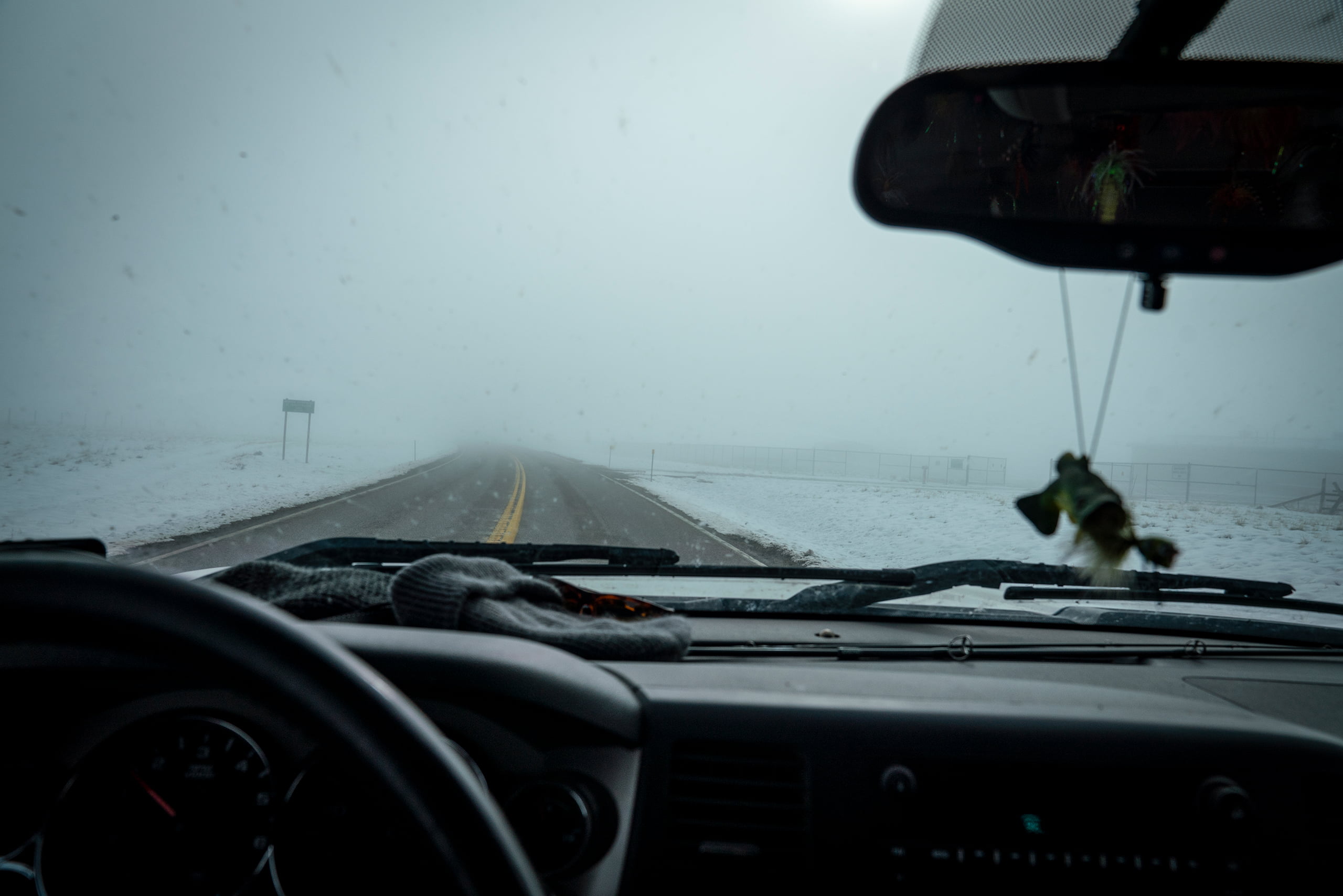
Blue-Wings
The most enigmatic of hatches.
Words by Spencer Durrant
I stood in a halfhearted drizzle with my back to a wall of willows while I surveyed the river. It was still at its wintertime flows, both the current and the fish barely moving. What I’d hoped would get the fish moving wasn’t showing up yet, and based on the weather and time of day, I doubted it would.
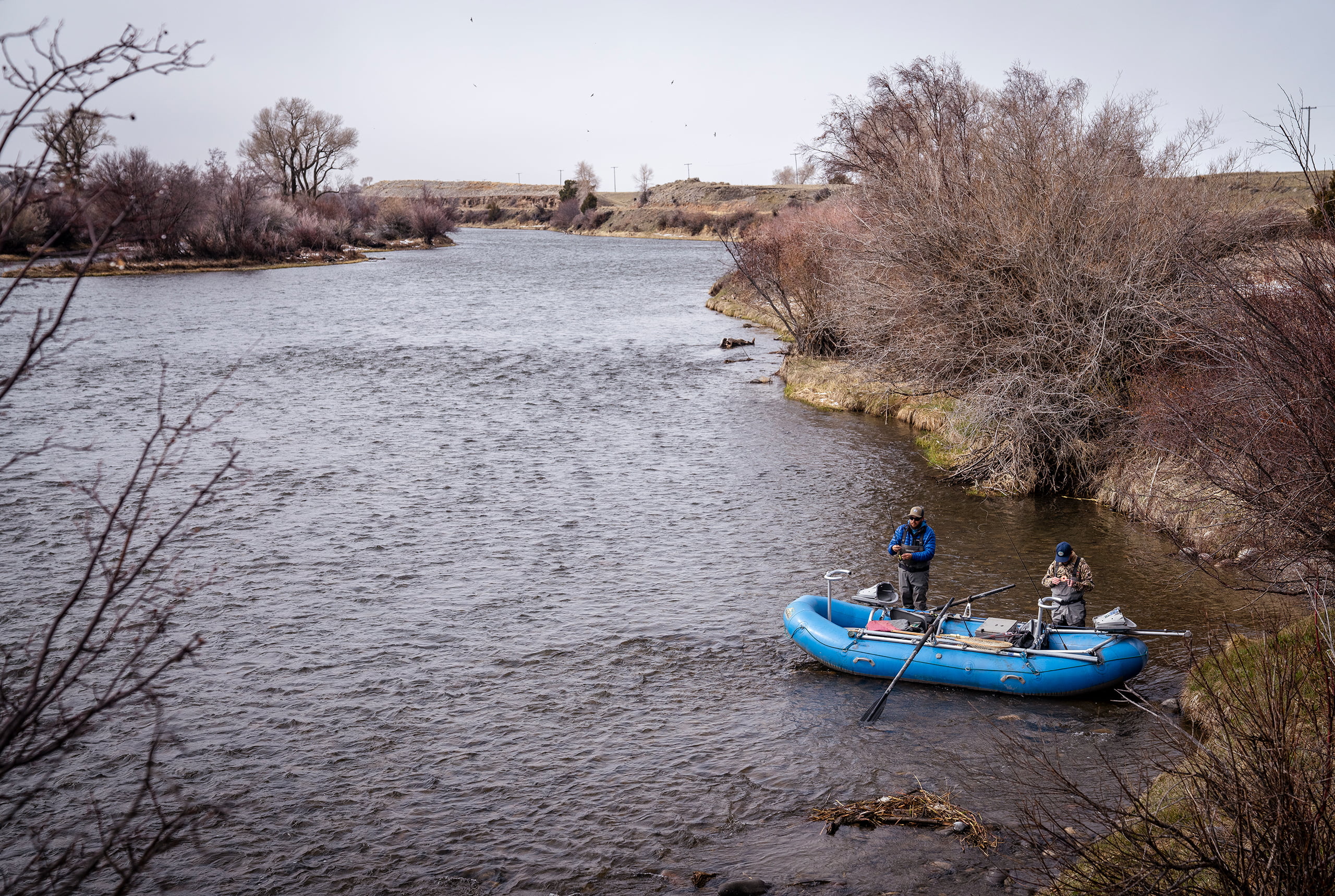
Ryan McCullough stood next to me and we watched his son Josh and my buddy Mike Kingsbury throw fruitless cast after fruitless cast.
“I can’t figure this out,” I said. “This is perfect weather. Perfect conditions. And nothing’s happening.”
Ryan nodded. “Yeah, it’s weird.”
The four of us were exploring a stream that was supposedly seeing good hatches of early-season blue-winged olives. The bugs were small, dark, and only came off when the weather turned sour. We’d planned the trip to coincide with weather just bad enough the bugs would be out, and hopefully few, if any, other anglers.
So far, we were the only things – fish or people – caught in the rain.
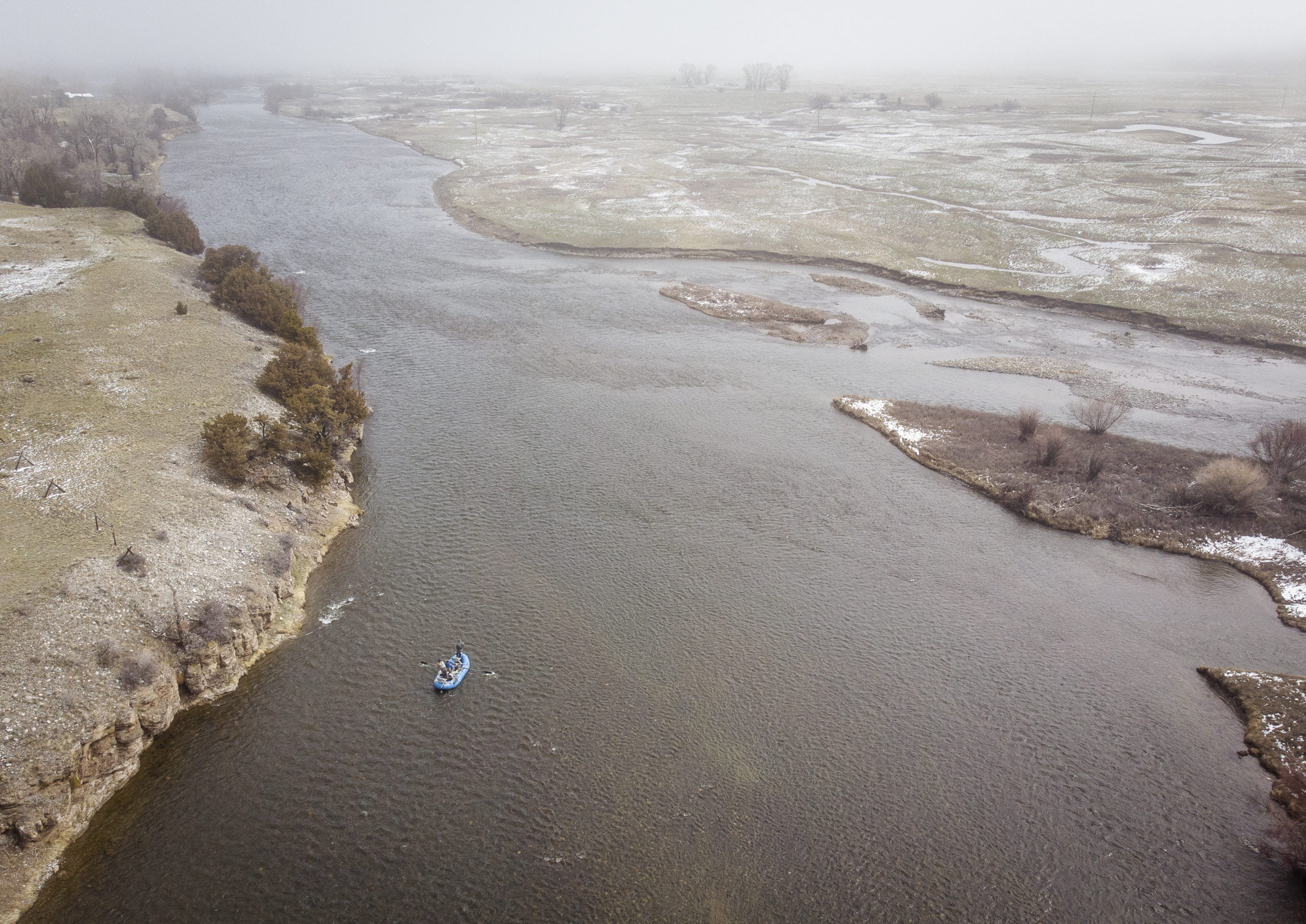
That we’d driven so far to explore a hunch only compounded the feeling that we needed something to happen soon. Mike and I both lived in Utah at the time, while Ryan and Josh drove down from Olympia, Washington. While any time I get to spend with Mike, Ryan, and Josh is certainly a win, we could’ve picked a more convenient location and time to break bread and catch up on life.
“Maybe we should’ve waited a few weeks for the skwalas,” I muttered.
Ryan shrugged. “Maybe.”
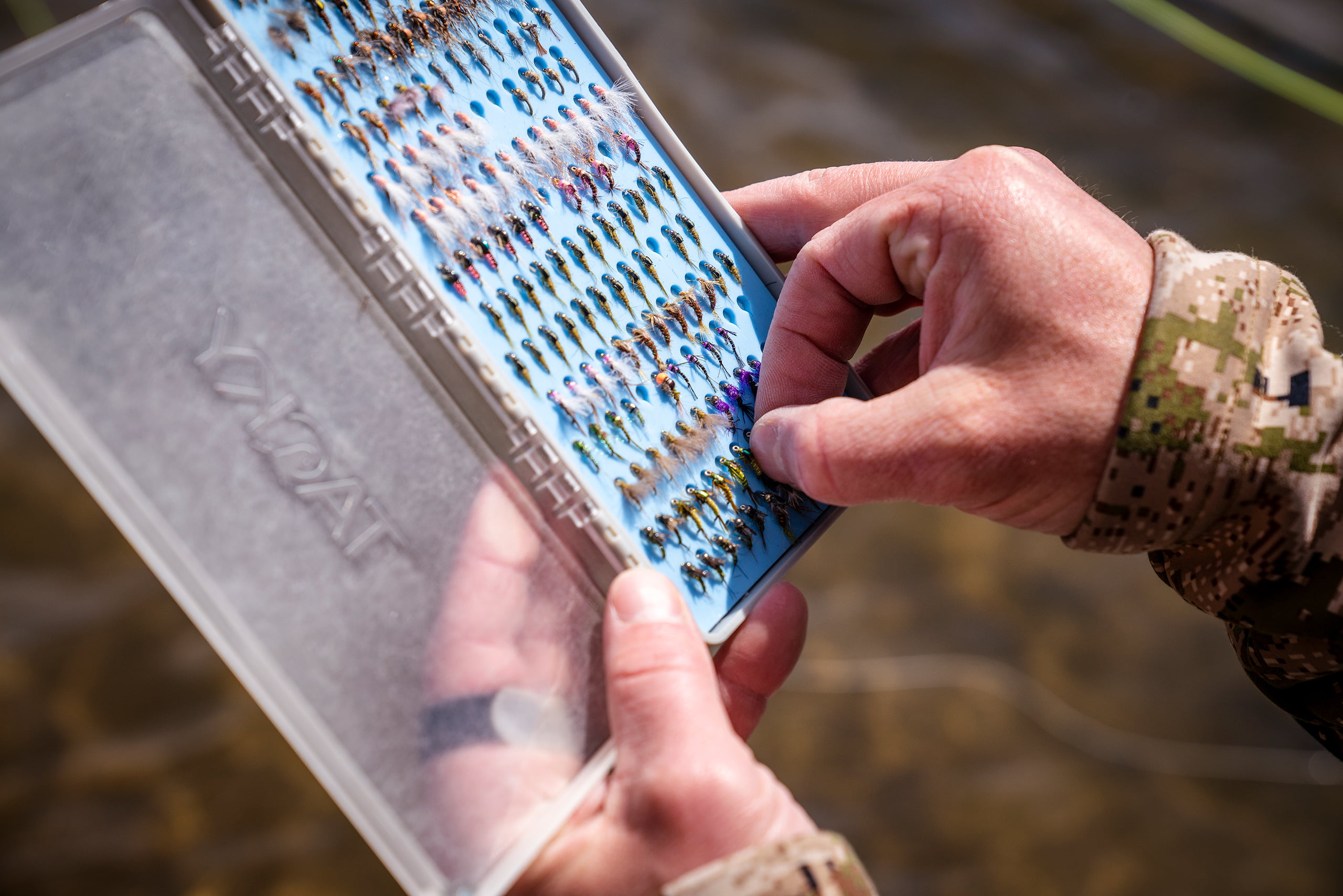
Then, cutting through the pitter-patter silence of a rainy day on a small piece of water, we heard the unmistakable sound of fly line going tight. Moments after, the whine of an old click-and-pawl reel filled the air.
“I got one!” Mike hollered.
Sure enough, he stood downstream about 100 yards, his fly rod bent in half. “It ate the dry!”
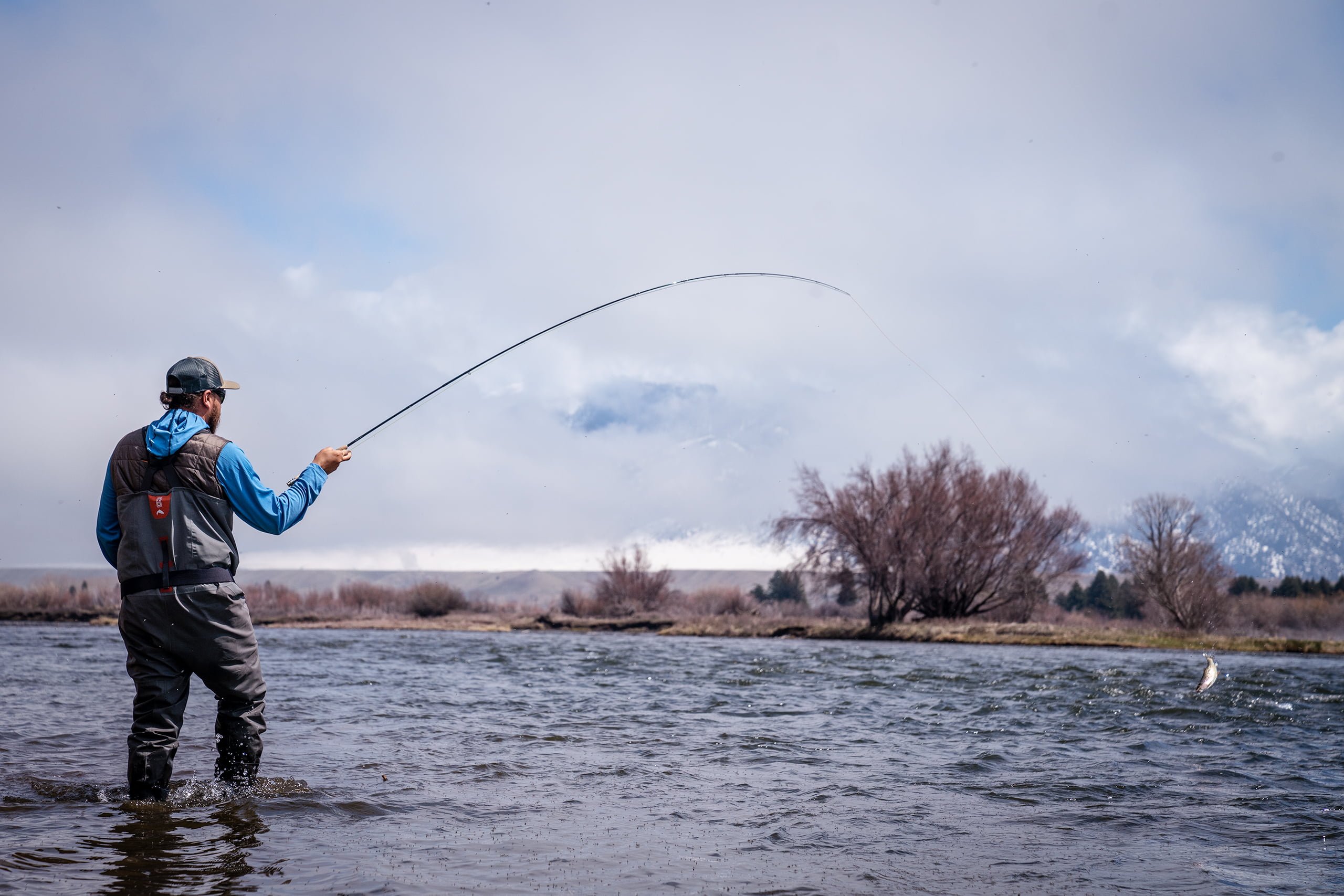
I glanced back at Ryan. “I haven’t seen any bugs yet.”
“Neither have I,” he said.
Mike played the fish quickly into the net, popped the hook free, then held the fish up briefly so the rest of us could see. Its pale golden flanks glittered dimly in the gray, flat light of midmorning.
Almost as soon as Mike let his fish go, Josh let out a yell. Ryan and I turned to face him, 100 yards upstream, just as the brown trout jumped, landed, then pulled off another 20 feet of line.
“Well, I guess they finally got the memo,” I said.
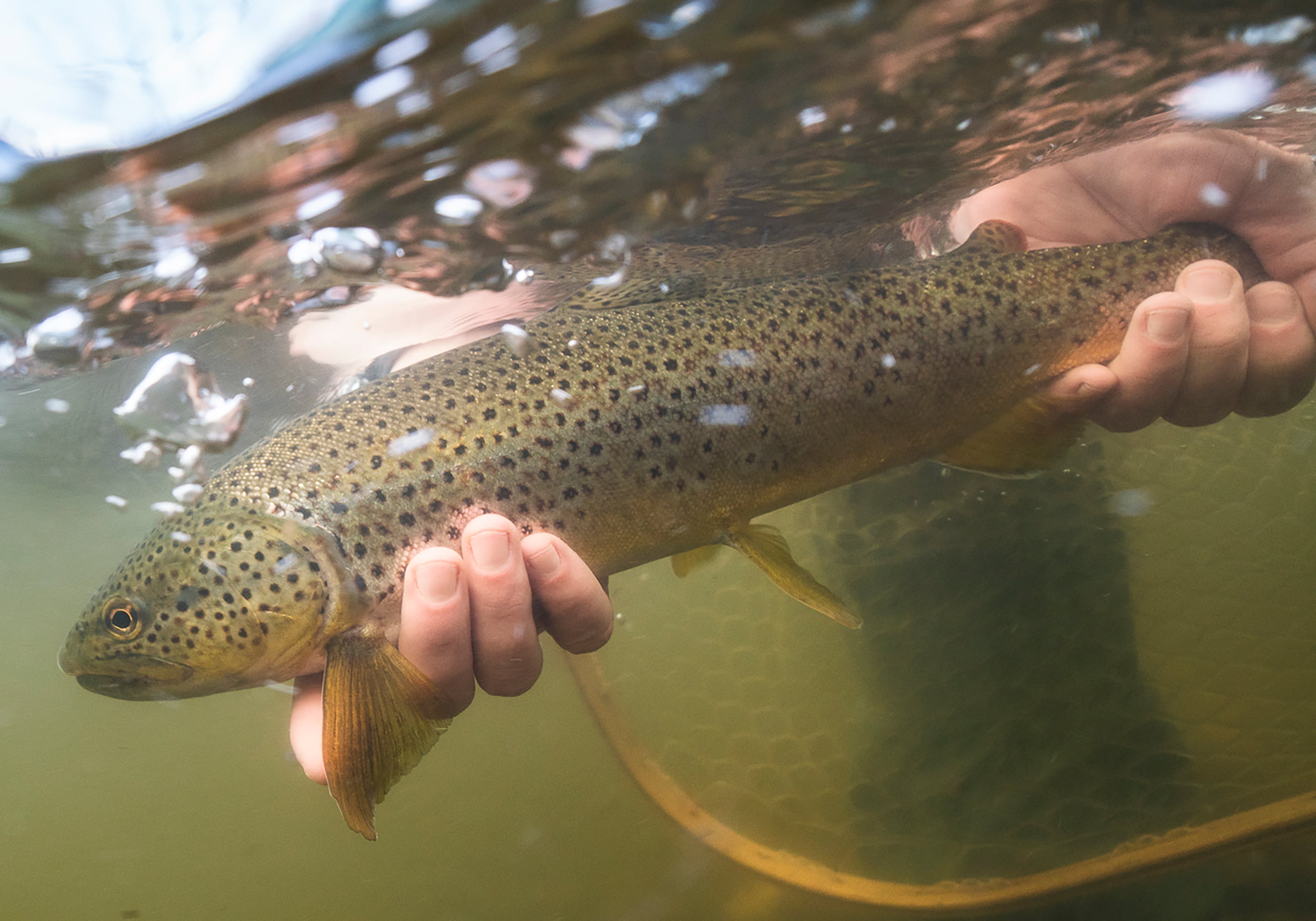
Ryan and I waded back into the water, giving each other enough room to cast. Between the raindrops, I saw tiny, dark bugs fluttering lazily. Mayflies tend to fly with a nonchalance that’s undoubtedly part of why trout love them so much.
As though someone had thrown a switch, the bugs came off in droves, and the fish reacted as you’d expect. Soon, the once-tranquil surface of the river was rolling from the unending series of rises as far as the eye could see. It was a perfect hatch. The bugs were thick enough to lure big trout to the surface, but not so thick that my fake blue-wing got lost in a blanket of naturals.

I don’t know how many fish I caught that day – I never started counting. The hatch was too good to worry about which fish I landed and which ones went free. It was a rare moment of angling nirvana, where you could thoroughly lose yourself in the machinations of the natural world.
The hatch finally petered out around 4 p.m., almost five hours after it began. The four of us fished without a break, pausing only to tie on new flies, tippet, or to grab the rapidly-depleted bottle of floatant from whoever remembered to bring it. My back ached, my feet were mostly numb, and I was down to my last battered spent-wing fly when I finally called it a day.
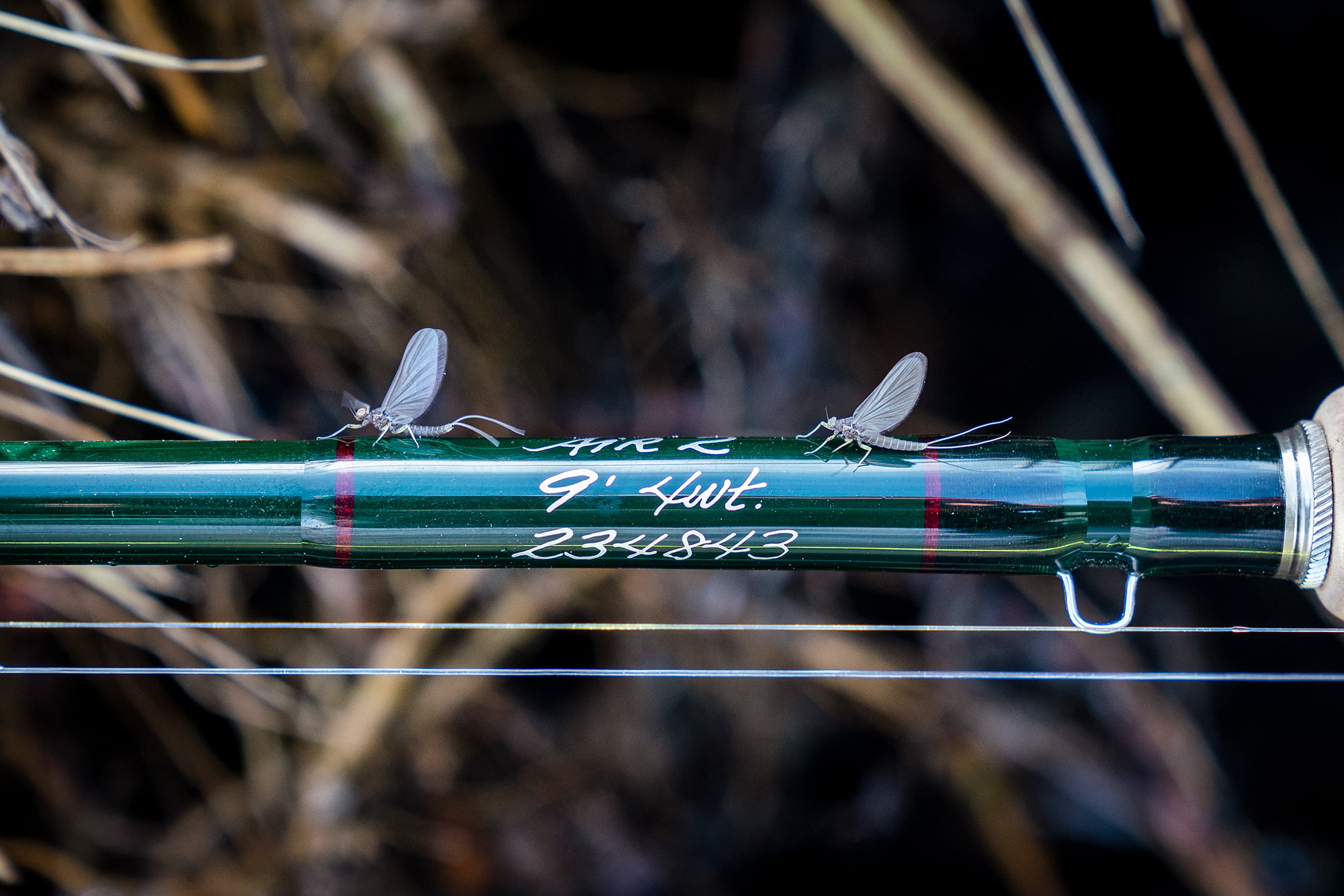
Back at camp, we shuffled around in a bit of stunned silence. To this day, that’s still the most magnificent blue-wing hatch I’ve ever witnessed. It reminded me of the picture so many folks I know try to paint of a stonefly hatch. A river full of fish, eager to eat, hitting the surface with something close to reckless abandon. The only difference was these fish weren’t hitting just anything. The slightest bad drift, or one too many false casts, put them down. I broke off a half-dozen flies, at least, because I set the hook before the fish had fully eaten my blue-wing. It wasn’t easy fishing by any means – the fish and the bugs kept me on my toes.
It was the sort of fishing that demanded good casting and attention to detail, but rewarded both handsomely. That I got to spend the whole day throwing dry flies only made the experience that much more unforgettable. I think that’s why I enjoyed that blue-wing hatch more than any other stellar dry fly hatch I’ve fished. Part of fly fishing’s allure is the idea that you’re waging some sort of passive fight against nature; that we only sometimes win is what keeps us coming back.
Spencer Durrant is a fly fishing writer, guide, and bamboo rod builder from Wyoming. He’s the News Editor for MidCurrent, and a columnist for Hatch Magazine. Connect with him on Instagram/Twitter, @Spencer_Durrant
Photos by Cole Leishman (@cole.leishman)
Featured Products:
 Air 2 9′ 4-weightThe perfect rod for dry fly fishing and light nymphing. The 9′ 4wt Air 2 features a fast action with a light tip capable of presenting delicate dries with long, light leaders. | 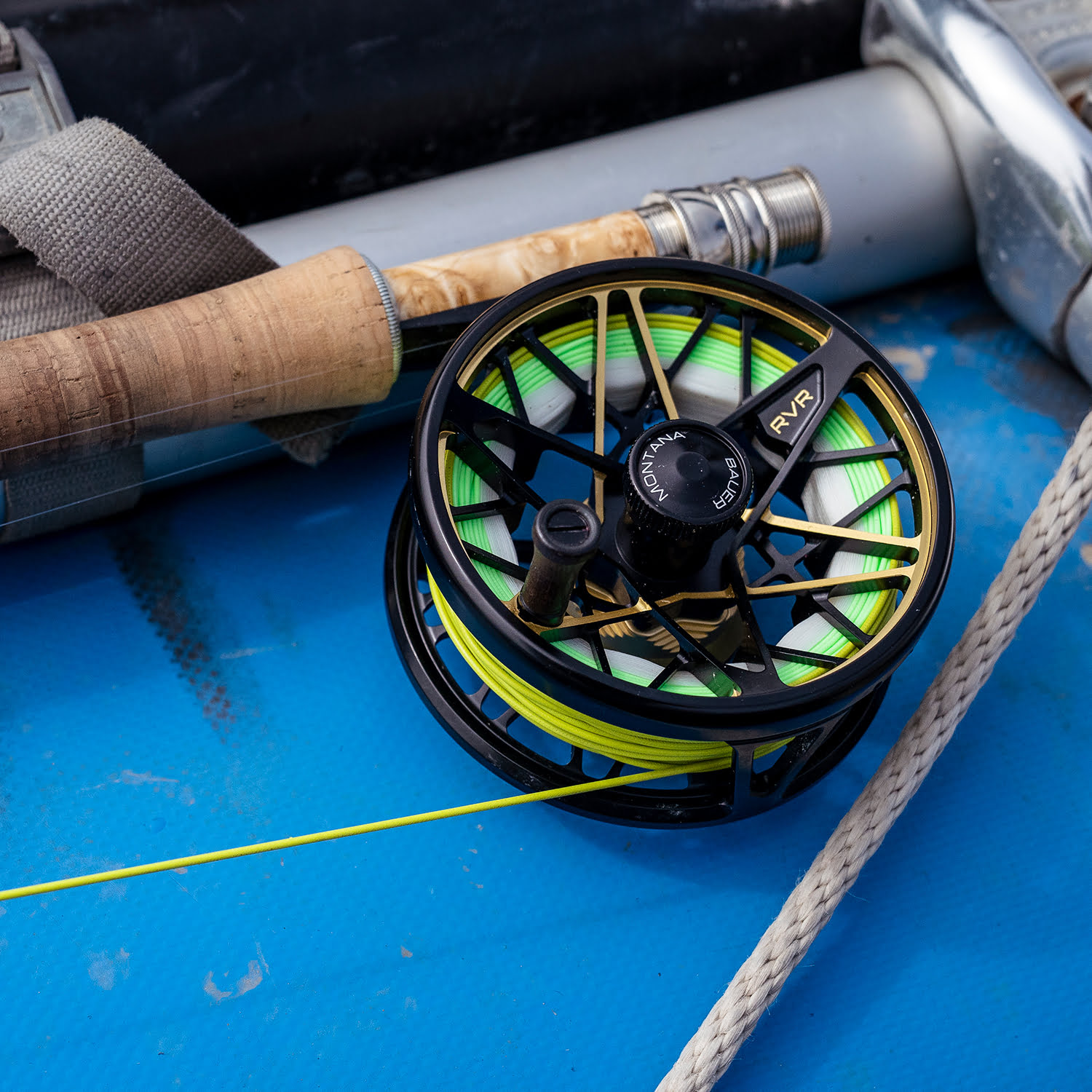 Bauer RVR 4/5Featuring the time-tested Bauer signature drag package and revolutionary 5-axis design, there is none other like it. | 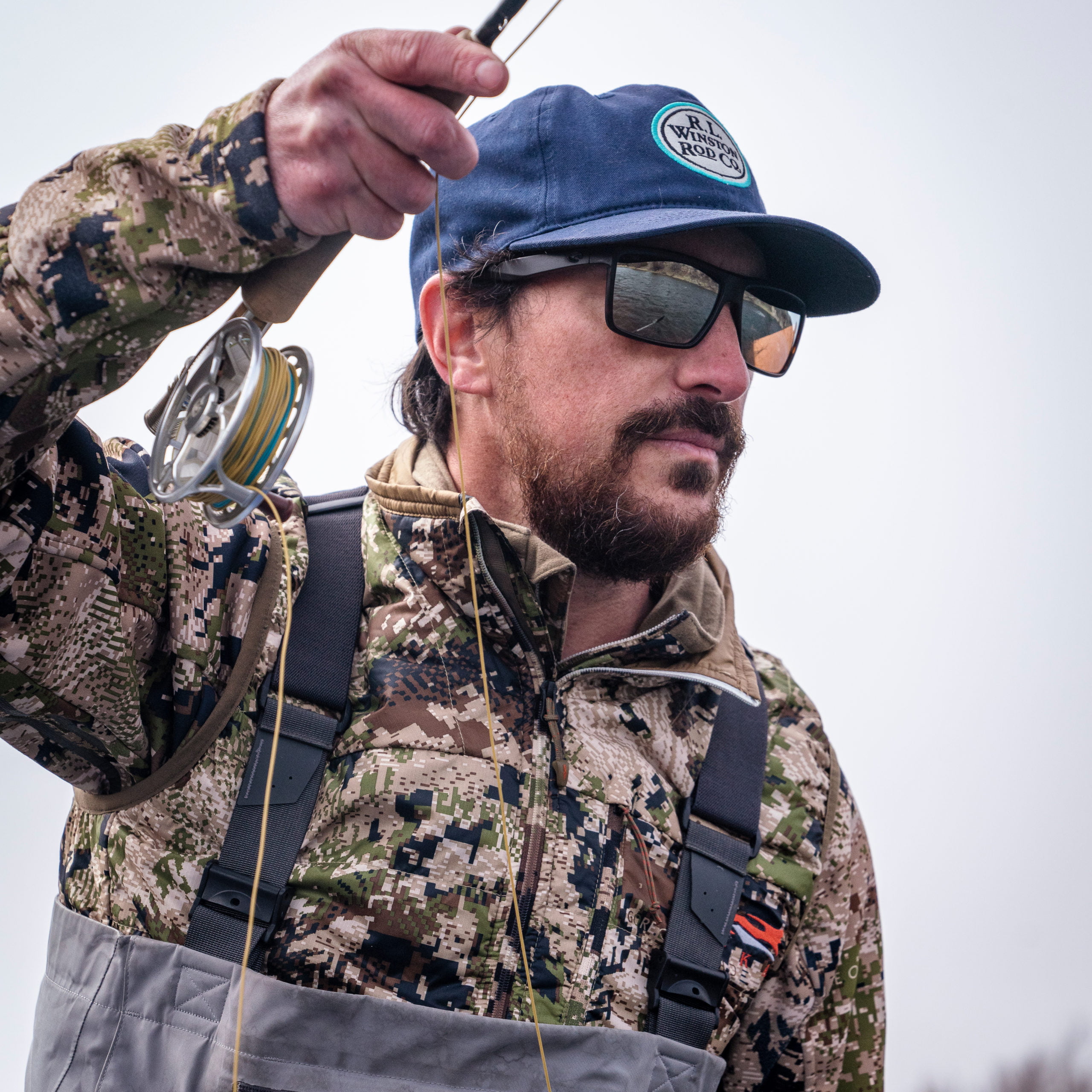 Tailwater HatOur classic Tailwater Hat is back with new colors: Moss and Navy. |  Double Haul Trucker HatThe quintessential summer trout fishing hat. The Double Haul Trucker is the perfect cap for fishing whether you’re in the salt or on the rivers. |
by Winston Rods | Apr 20, 2022
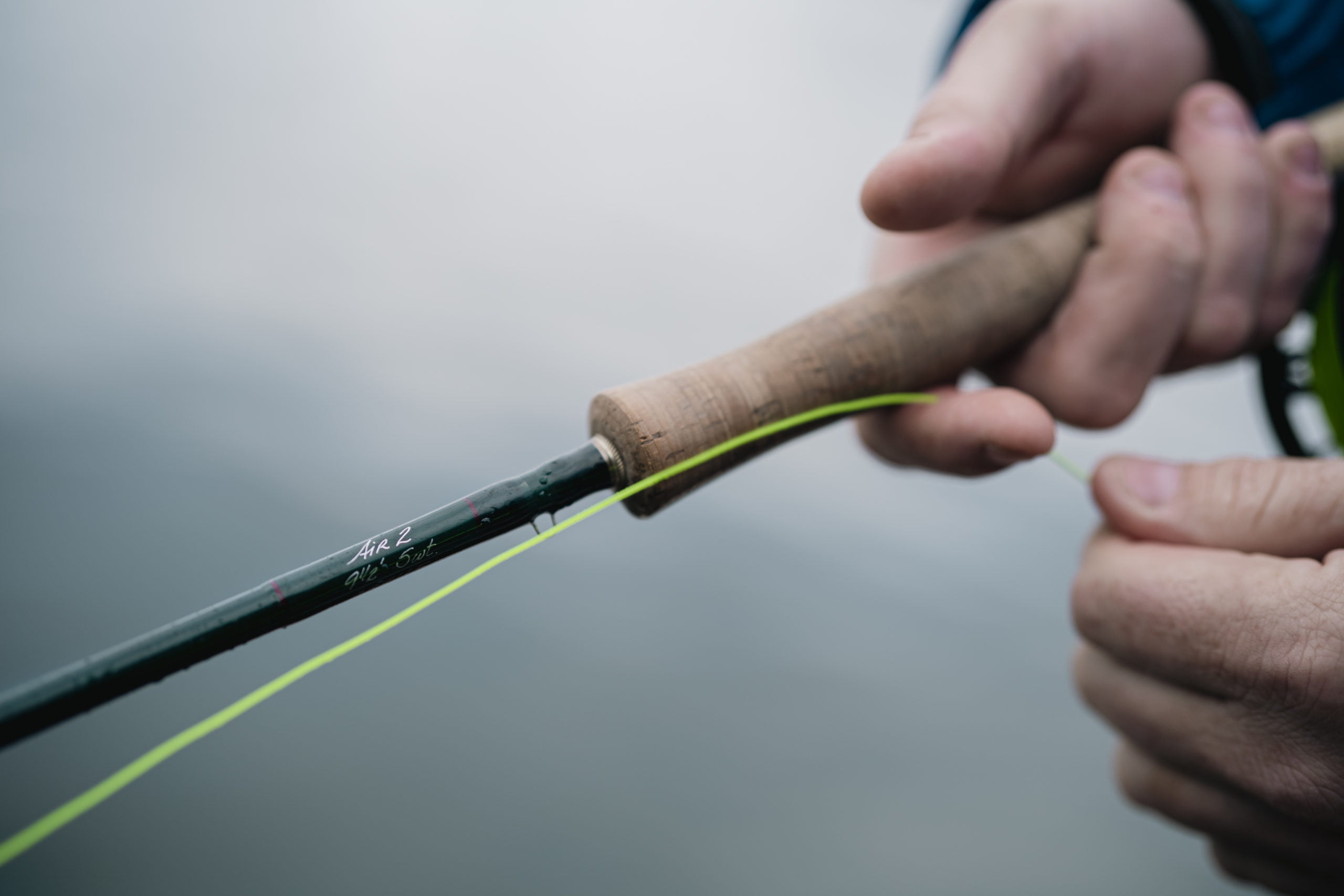
Words By Brett Wedeking
There’s a million rods out there these days and a million opinions on what the best one is—and a lot of hype. It’s impossible to say what “the best” rod is out there, but Winston’s Air 2 series makes a persuasive argument for top billing. Over the winter I had the opportunity to fish the new 9’6” 5-weight Air 2 on my homewaters of Puget Sound. What a treat it was.
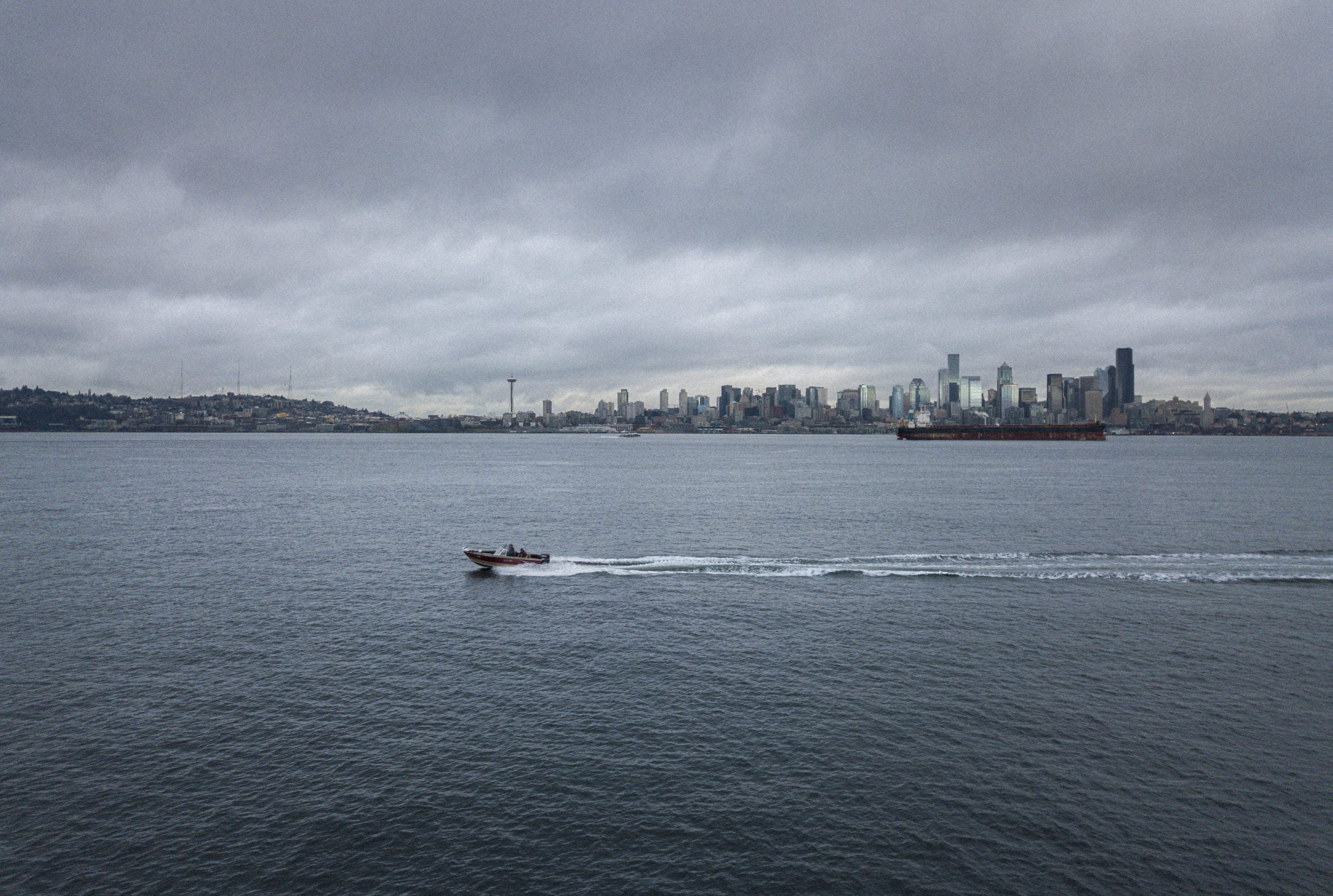
While my Puget Sound fly fishing is technically trout fishing, it’s unlike any other trout fishery on the planet. We need powerful rods that can zip out shooting heads and weighted flies with ease, repeatedly, but still retain a light and sensitive feeling in the hand. And, we’re talking 5-6 weight rods, this isn’t striper fishing. Blending power and finesse is a difficult task but this model finds the sweet spot on every cast, every hook up.

To say this rod blends power and finesse is unfair and simplistic, however. This rod generates the type of power you’d normally find in a 7-weight. And that kind of power is rarely blended with the delicacy and presentation accuracy of this rod. I’m a fan of longer rods for big rivers and this rod is perfectly at home on rivers like the Deschutes, wading thigh deep on slick rocks, trying to sling a stonefly around an upstream bush. Feel confident that the fly will drop where you point the rod and not six feet up in the bush. The line control that six extra inches provides is beautiful. Big mends and high sticking are cake. Roll casting is buttery and effortless.
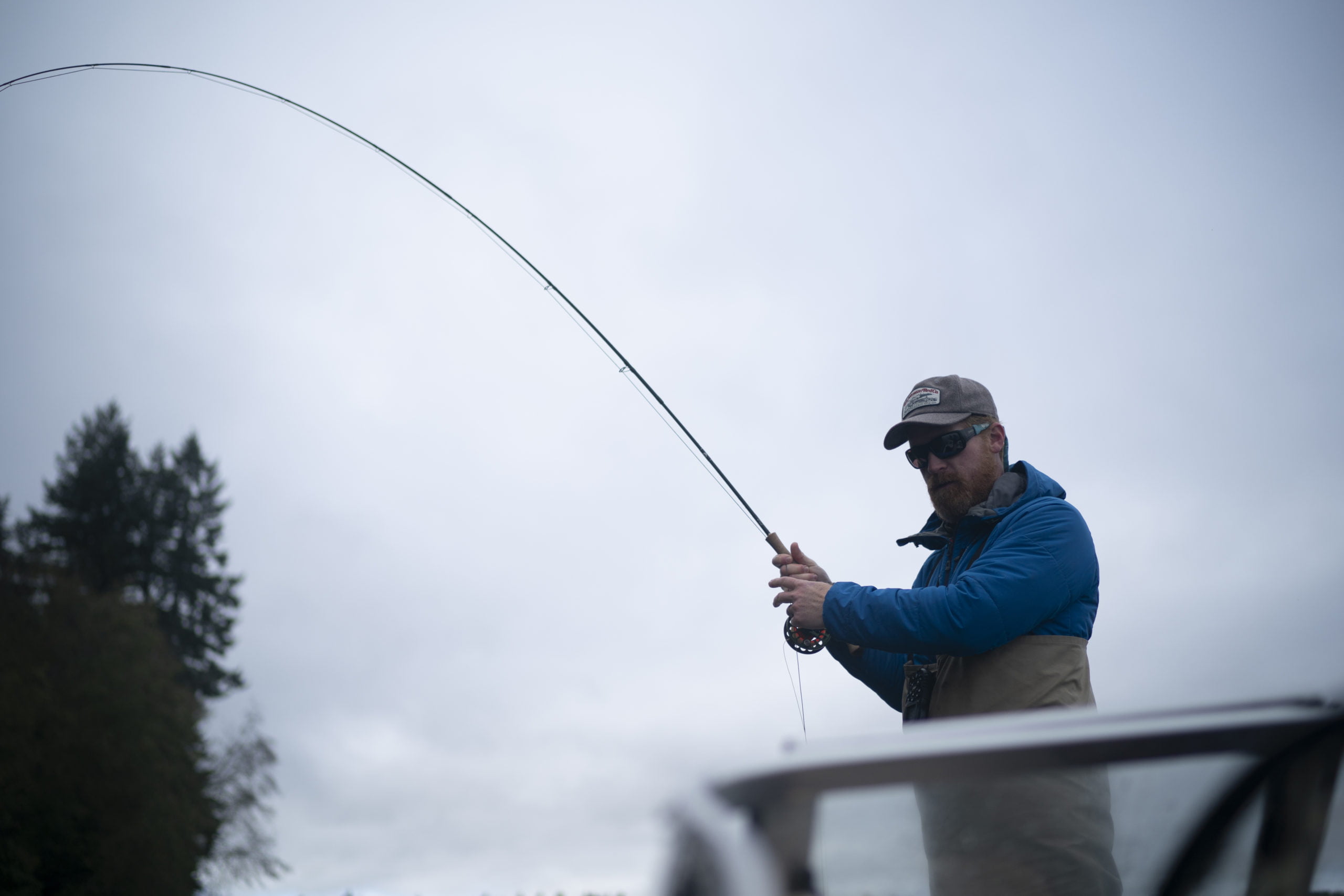
The length slows down the cast and the rod bends deep into the butt, with kinetic feel from tip to cork. That feel is equally important when trying to sling a baitfish pattern 80’ to the beach or dropping a PMD emerger behind a boulder. While I only fished the former situation with this model, this stick would be my first choice for the South Fork of the Snake in July, where you’re double hauling bushy stoneflies along the bank and fishing hatches in the riffles on the same afternoon.

This rod excels at throwing a variety of fly lines. For floaters, I’d match it with an SA Trout taper or Infinity taper all day long. Don’t be afraid to load a heavier taper either, for turning over bigger bugs. This rod will handle it. I was thoroughly impressed by this rod turning over the shooting heads and baitfish patterns we fish on Puget Sound. I put a 6-weight Rio Coastal Quickshooter and 6-weight Outbound on and the rod slung both lines as far as I cared to cast, with tight loops, in a breeze. This is not your average 5-weight trout rod, folks. Streamer fishing in Montana, New Zealand browns, nymphing on Upper Sacramento, stoneflies on the Yakima, wherever you’re going, this rod is a grade-A option. And, I can’t wait to try out the heavier models.
For more info on Seattle fly fishing in Washington’s Puget Sound and local rivers, check out Tailout Anglers or @tailoutanglers on Instagram.
Photos By Greg Sweney
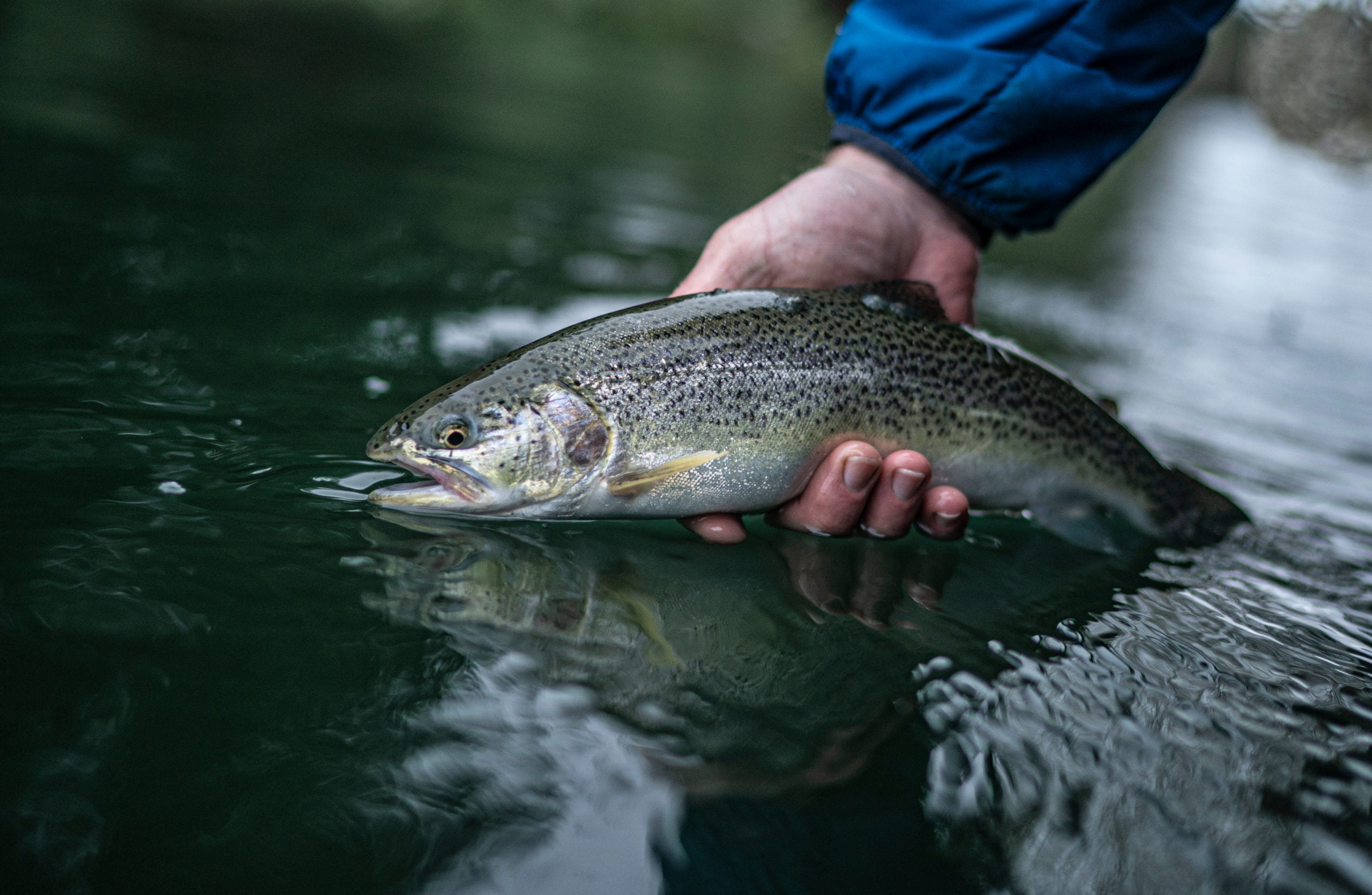
by R.L. Winston Rod Company | Mar 10, 2022
 Words by John Duncan (Telluride Angler)
Words by John Duncan (Telluride Angler)
My guarded expectations were blown away by this model. The rod rolls gorgeous loops off the light and sweet tip as if dry flies were the only way to fish. Elegant, sensitive and plush, it casts from short to long with the cadence of a finely tuned instrument that any angler will handle with intuition and precision.
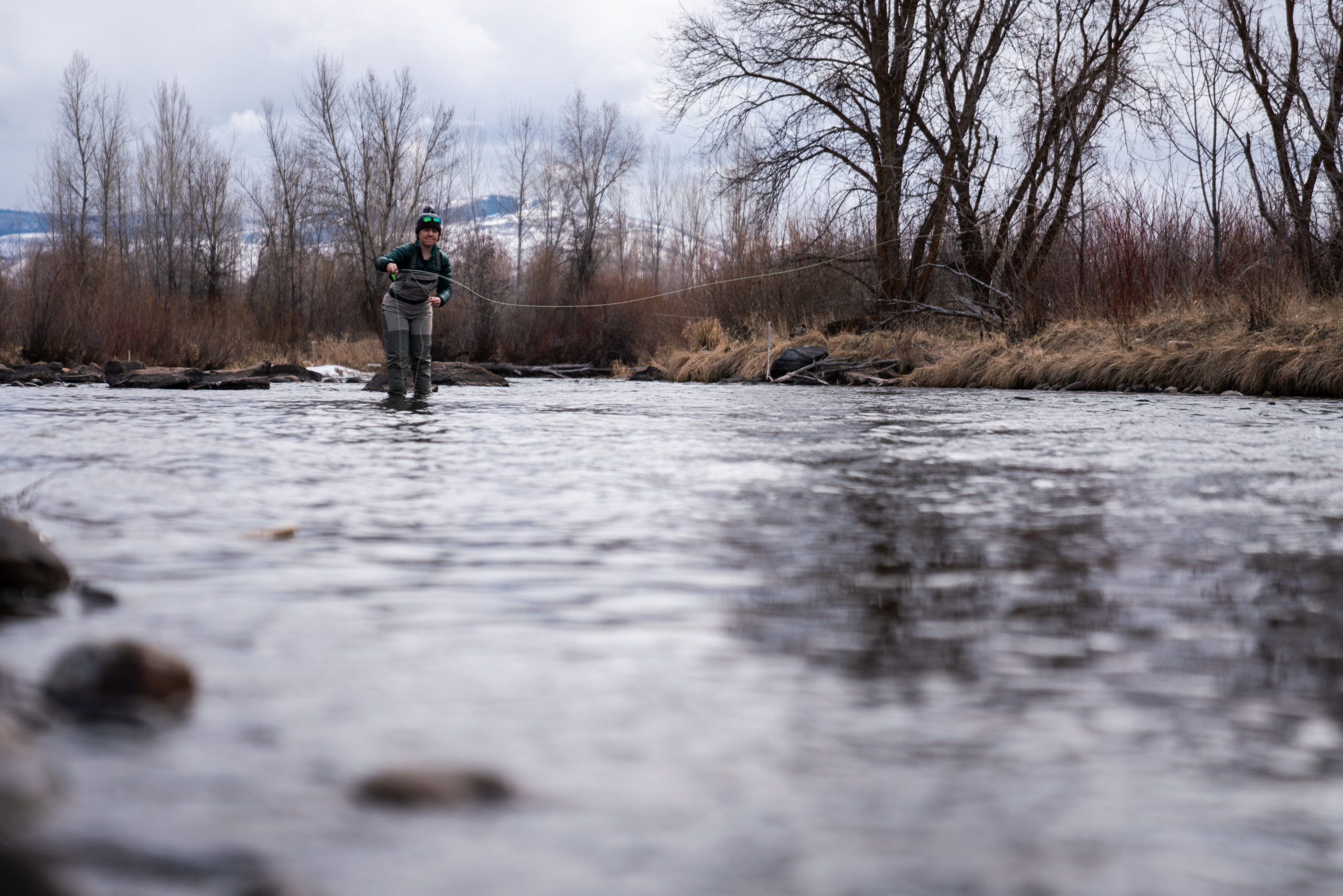
Fish it with an SA Trout Taper. It will handle slightly heavier lines, such as the Rio Technical Trout or Gold, but why not split hairs and bring out the very best? The 9′ 3-weight is one of the faster action rods in the series. Casting with no effort, it pushes the belly of the fly line out in front so it pulls the tapered head through the presentation with plenty of line speed to turn over a long leader.
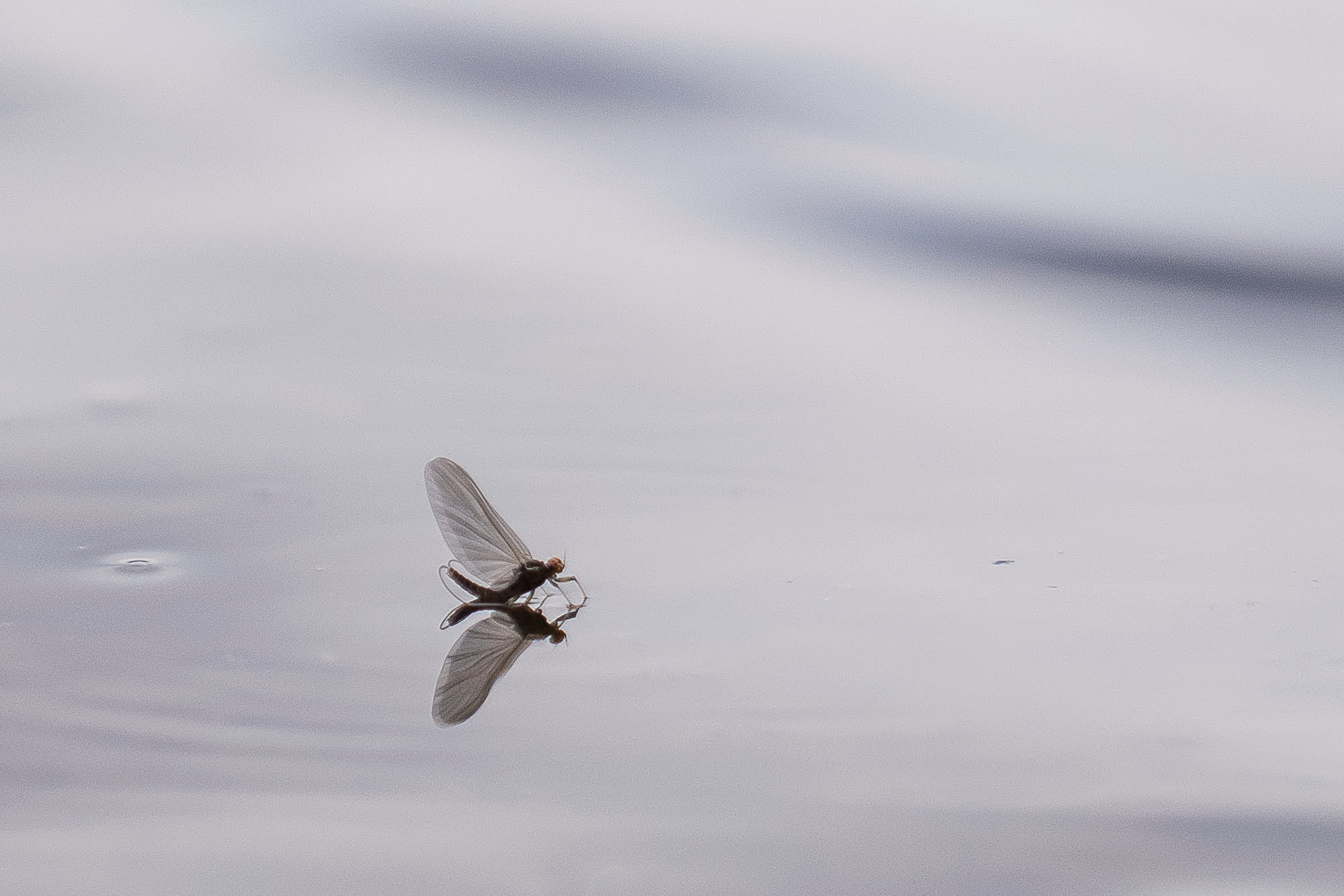
Some of our staff feel that it’s best beyond 30 feet, but I found that it loads naturally from very short to very long. If a double haul is required for casting in the wind, tap it lightly and expect a confident response. It’s hard to make a bad cast with this rod.
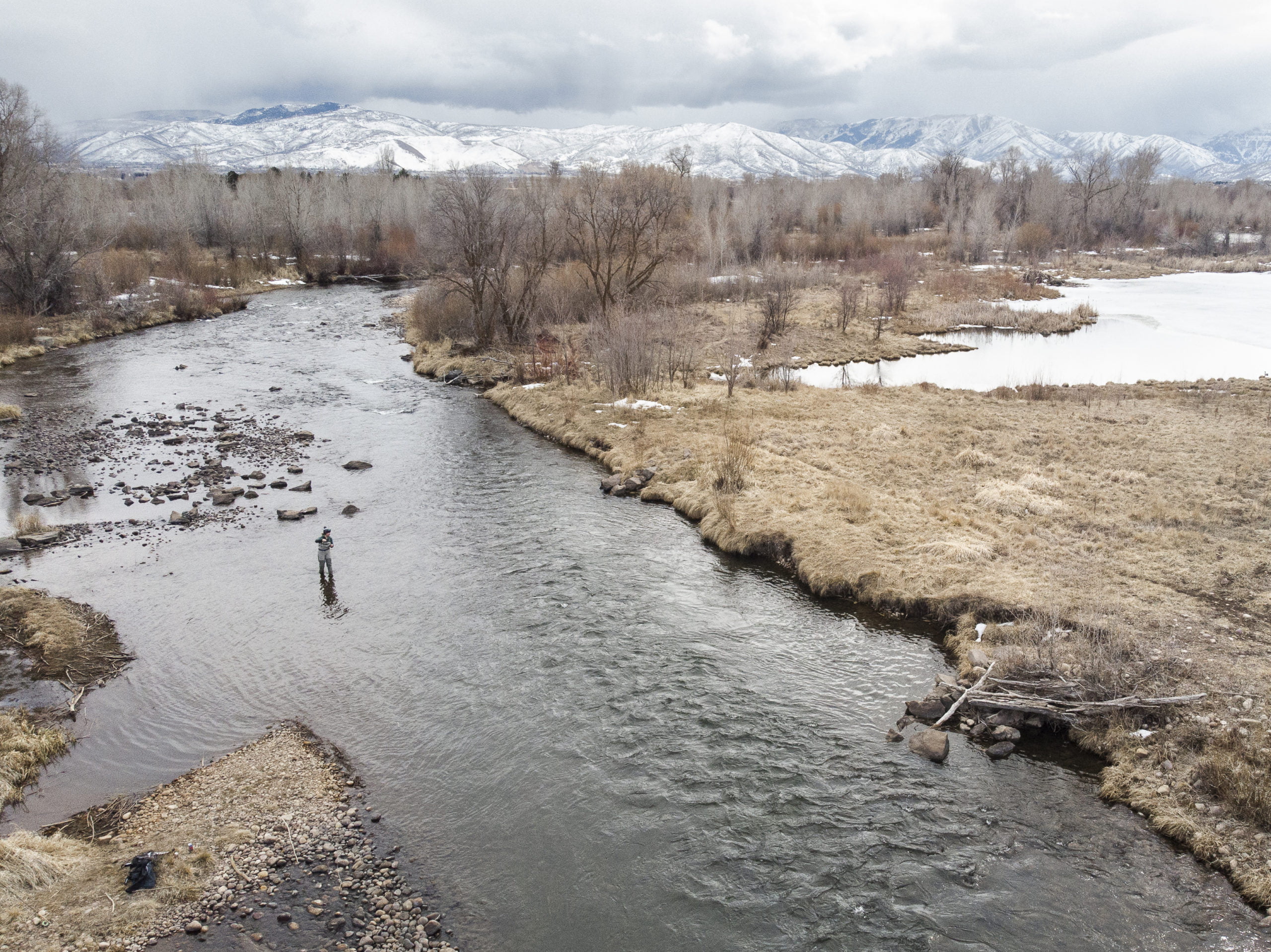
In spite of its fast action character, it possesses wonderful roll casting and line mending qualities along with the tippet protection you would expect from any Winston. Spring creek and tailwater anglers have a new favorite rod. From the Delaware and Silver Creek to the Frying Pan and Green, this Winston will rise.
Photos by Cole Leishman

by Winston Rods | Feb 9, 2022

Words by Brett Wedeking
I chased Redfish last fall in the Biloxi Marsh of coastal Louisiana. I had never cast at a Redfish before and had preconceived notions about what to pack, how to fish, and what is appropriate gear. As it turns out, I was mostly wrong. But, learning and discovery is what fly fishing is all about. So, while I’m still a novice Redfish angler, I have a few thoughts to share for anyone considering a trip to the marsh.
1 – The single most surprising aspect of redfishing, for me, was how short and quick the shots were. While similar to classic flats-style fishing, redfishing is unique and presents its own, fun challenges. I ignorantly expected to spot fish at distance, and wait for the guide to work the boat into position to make the cast. Ha! Our shots came fast and if you weren’t ready with a fly in hand you were toast.
The water is not clear like the Bahamas or Belize, and the bottom is usually mud or sand, with bits of shells mixed in. On top of that, the late fall sun doesn’t ever rise straight up overhead. Consequently, spotting fish at 120 feet isn’t really a thing (unless they’re pushing a wake in shallow water). Our shots came from 15-40 feet. And, when the guide says, “I got a fish, 30 feet, 1 ‘o clock,” you need to spot the fish, lift your rod and begin the cast all at once. It’s fun and fast, both exhilarating and heartbreaking.

2 – Lining your rod correctly is always important and critical for redfishing. Due to the quick nature of the casting opportunities, you want a short tapered, quick loading line. The Redfish specific lines are exactly what you want. They load quickly and turn over flies accurately. Trout/steelhead nymph tapers are another good option (without the high-vis tip). They have heavy, short tapers that are meant for turning over junk at shorter distances. You do not want to fish a standard Bonefish taper or trout taper. Those style of lines have long tapers that won’t load and turn over weighted flies quickly, on short shots. Water temperatures are important (duh!), not only because it dictates fish activity but dictates what lines to use. There’s a reason manufacturers produce both winter and summer redfish lines. Just as you wouldn’t fish a trout line in Panama, you want to match your line to the water temperatures you’ll be fishing.
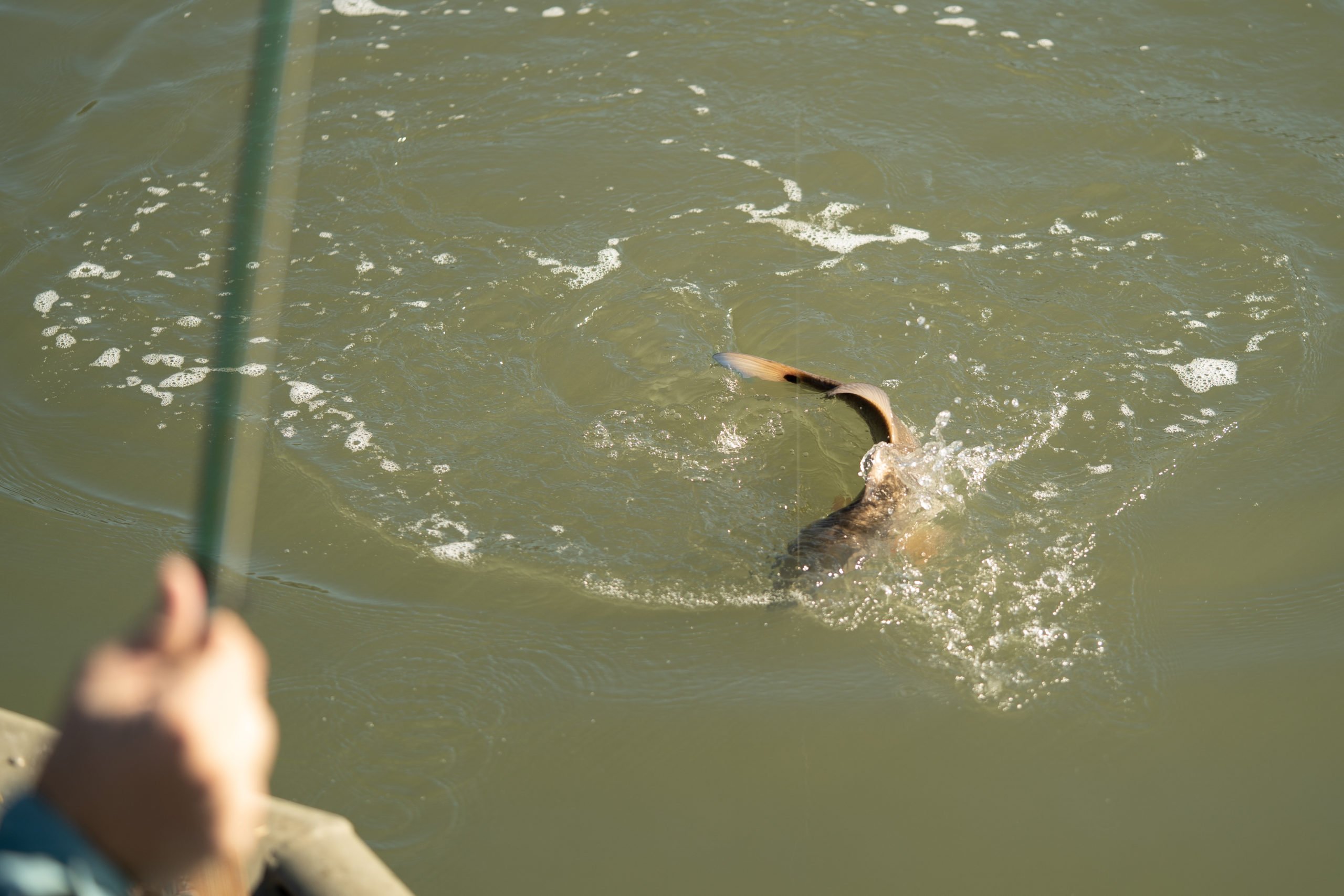
3 – A happy Redfish will eat just about any fly you put in front of its face. However, while they aren’t Permit, reds can get a little picky about fly size, weight, color and presentation. We fished a lot of dark colors like black and purple with bunny tails and brass eyes, 3-4” long. The water is often stained and the bottoms dark and silty so a fly that shows a strong silhouette is more visible. Lighter color and lighter weighted flies are important to have ready too. We learned that in clearer and shallower water that crab and baitfish patterns in tan or olive would be hoovered up, while heavy, dark flies were ignored.
Even smaller reds can get spooky, depending on tides, weather, and angler pressure. Naturally, the bigger fish will be a little more wary, but are regularly fooled and will pull hard and run far. Don’t be complacent, make the best presentation you can, every time. Trust your guide. I’ll say it again, trust your guide.
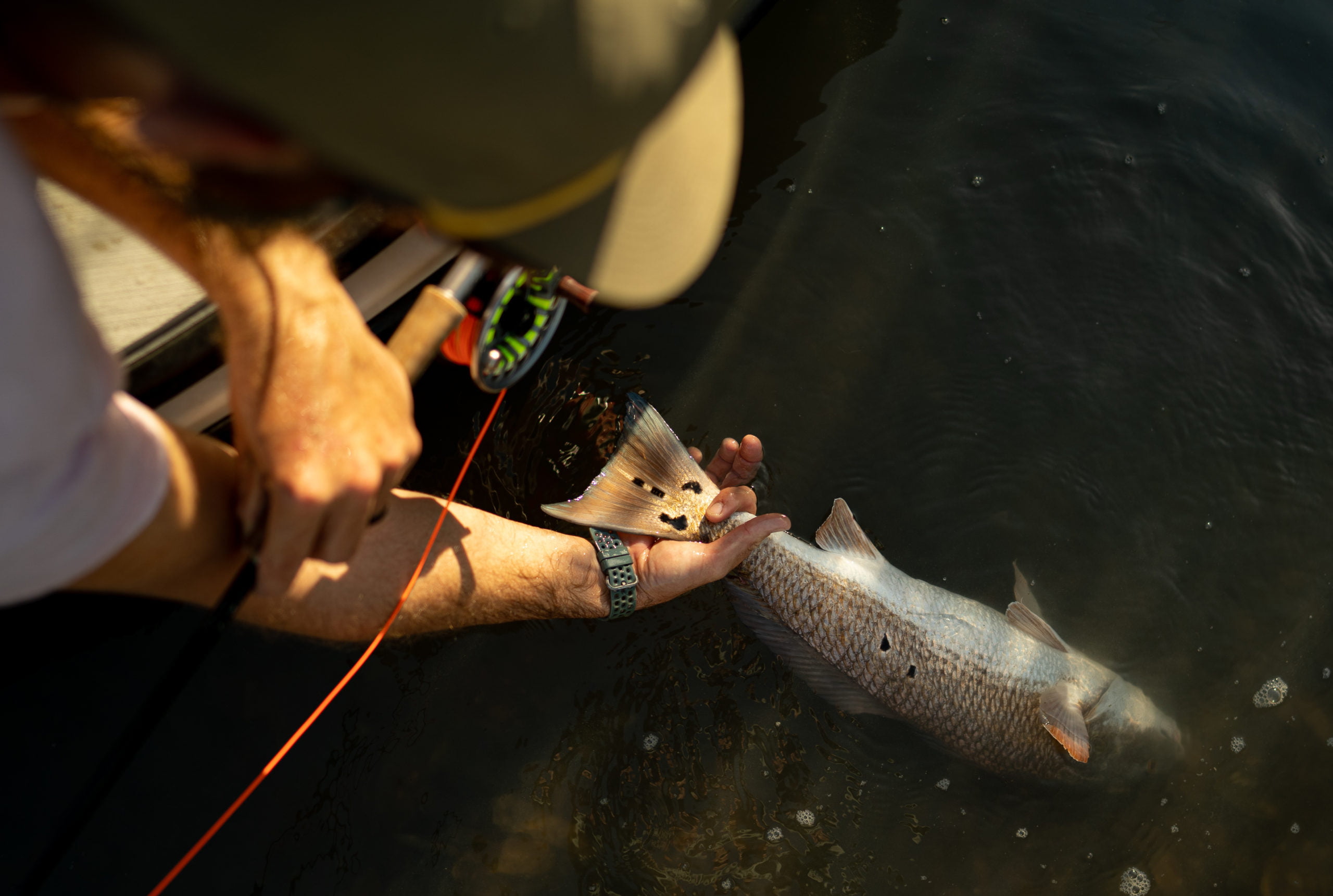
4 – It pays to have a popper rod rigged and ready to go. You can find plenty YouTube videos showing big bull reds destroying poppers, and that’s a good way to get jacked for an upcoming trip. However, just like trout fishing, reds eat a subsurface offering more often than on top. But, we aren’t bait fishing, we are fly fishing, and the challenge is part of the point of it all, so when you see reds pushing bait in 8 inches of water, grab the foam, throw an accurate cast and enjoy the show.
5- A house on stilts is constantly moving and shooting pool in these conditions makes for a challenging game even when you haven’t dipped into your beer fridge yet.
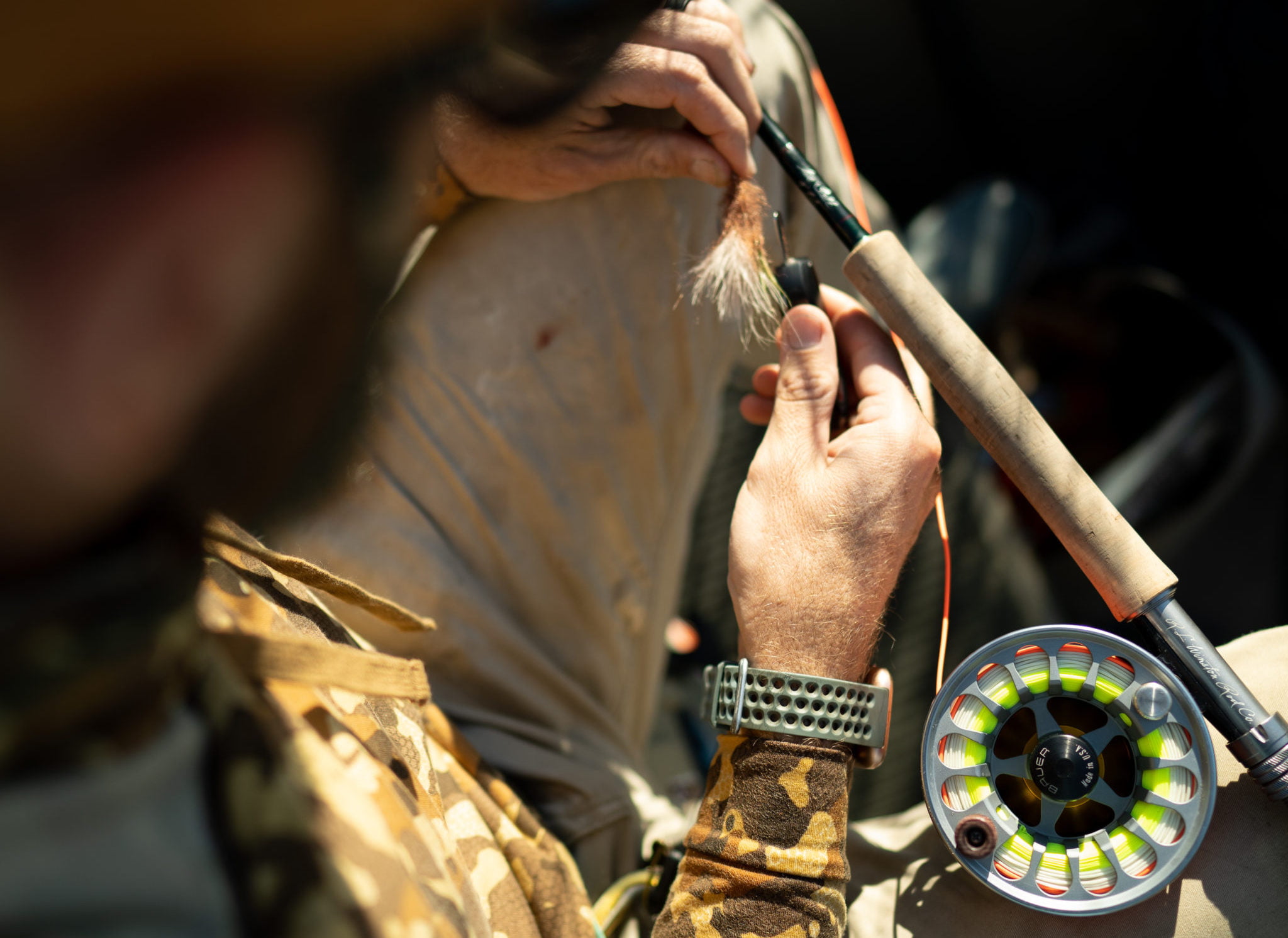
6 – When traveling to fish and spending precious vacation time, you want reliable, high performance gear. I took a pair of Saltwater AIR rods, a #8 and #9, to the marsh. I was impressed with both rods and they match well with the needs of redfishing. These rods are fast and require a heavy tapered line to load quickly and make short shots, especially for this type of fishing. When you get the right combo, the sweet casting becomes even sweeter when you hook up. These rods are extremely powerful and throw tight loops in the wind. They track straight and turn over weighted flies despite windy conditions. Accuracy is important for reds and the Saltwater AIR rods put the fly exactly where you point the tip. These rods also have good lifting power to turn big fish headed for the deep.
Though I didn’t get to fish the Alpha+ rods for reds, given the fishing I’ve done with them at home, I’m taking a full quiver down next time. The Alpha+ loads deeper than the Saltwater AIR and maintain exceptional feel through the casting stroke (think like a modern version of the classic BIIx rods). These rods bend into the cork to unleash high line speeds and straight casts that easily translate to precision accuracy when it matters. Alpha+ models tame the wind and deliver flies where you want them. And when you hook a good one, you’ll find that the rod bends deep, while maintaining a ton of power and control.
If you only pack one rod to fish reds in the marsh, make it a #9. This gives you maximum versatility for fly size, fish and wind conditions. A #8 is excellent for throwing poppers or calmer conditions. Some anglers prefer a #10 and that’s a good idea too, especially if you have extremely windy conditions and are casting heavier flies in deeper water.
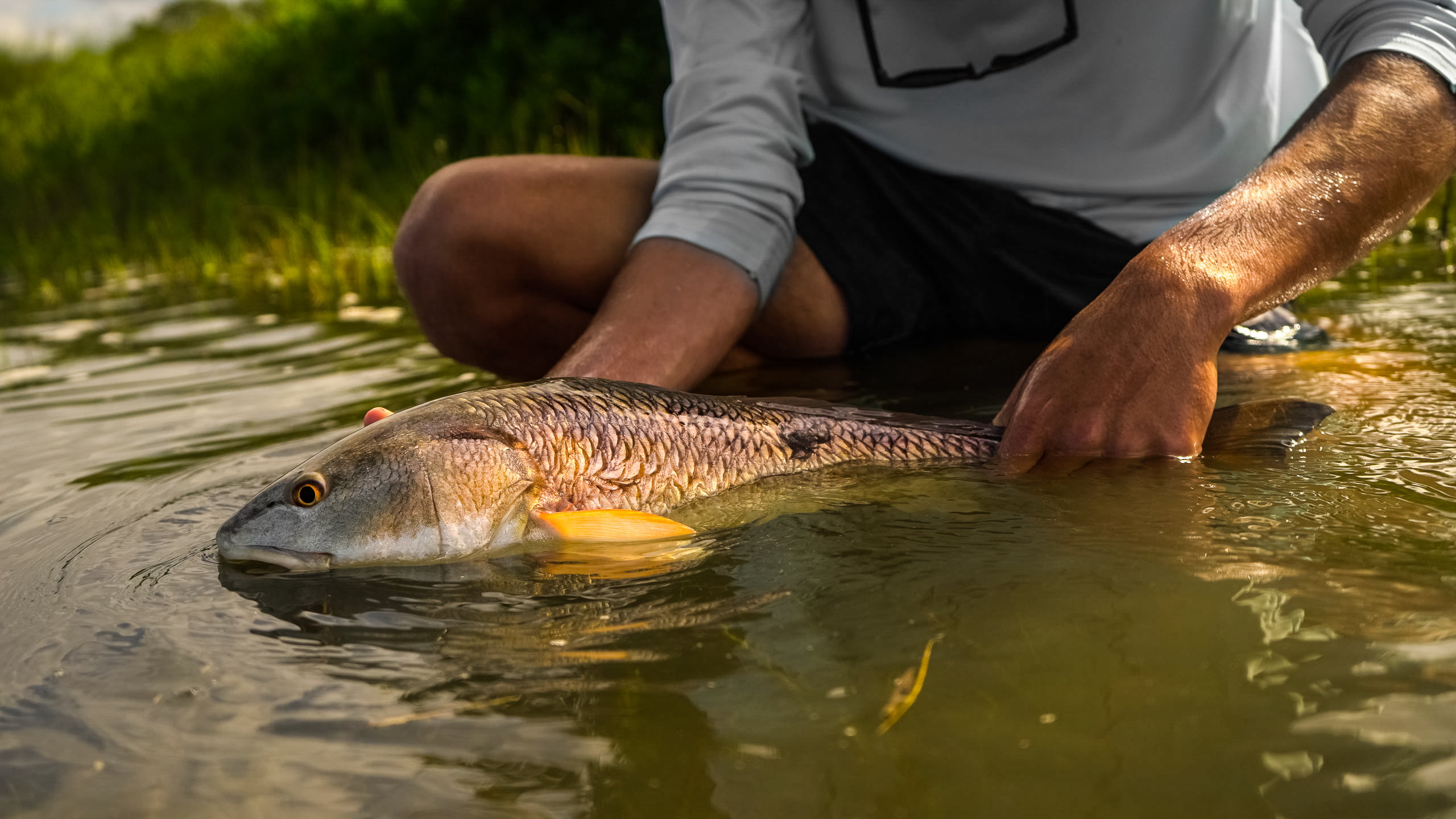
7 – While you won’t have a Redfish peel 200 yards of backing off your reel like a GT or Tarpon, the big ones still pull hard and will test your gear. On top of that, you’re fishing brackish saltwater, which can be harsh on reels. For these reasons, you should bring a machined aluminum reel with a solid disc drag. The marsh is not the venue for plastic cassette reels. The Bauer RX series is perfect for saltwater applications like this.
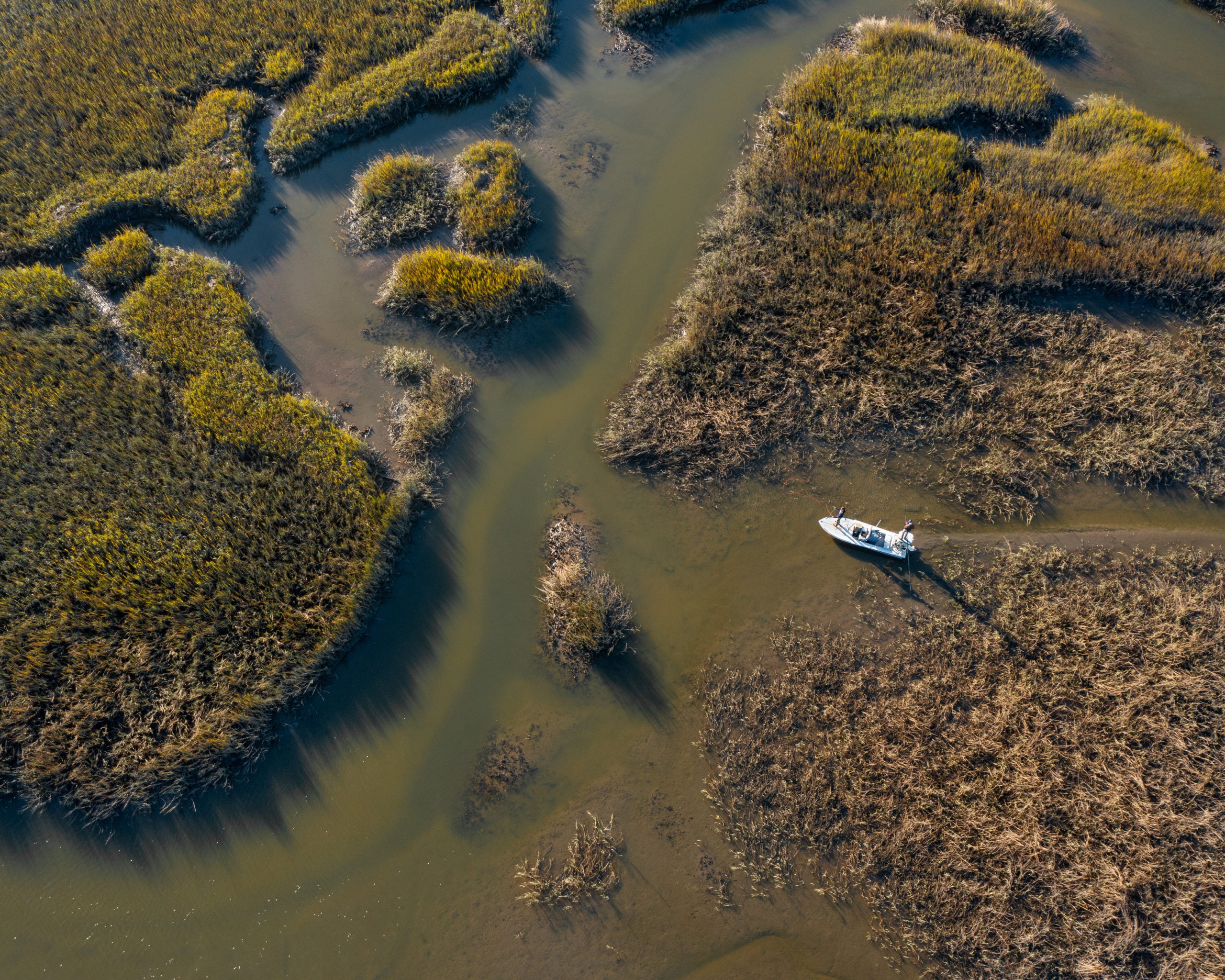
8 – Even though Redfish receive the modeling contracts, the fun variety of species available in the marsh was unexpected. Our group caught reds, Black Drum, Sheepshead and Sea Trout. In warmer months, you will get opportunities at Jack Crevalle and Alligator Gar too. Traditionally, anglers chase bull reds in fall when the biggest fish migrate to the flats, but big fish can be found year-round.
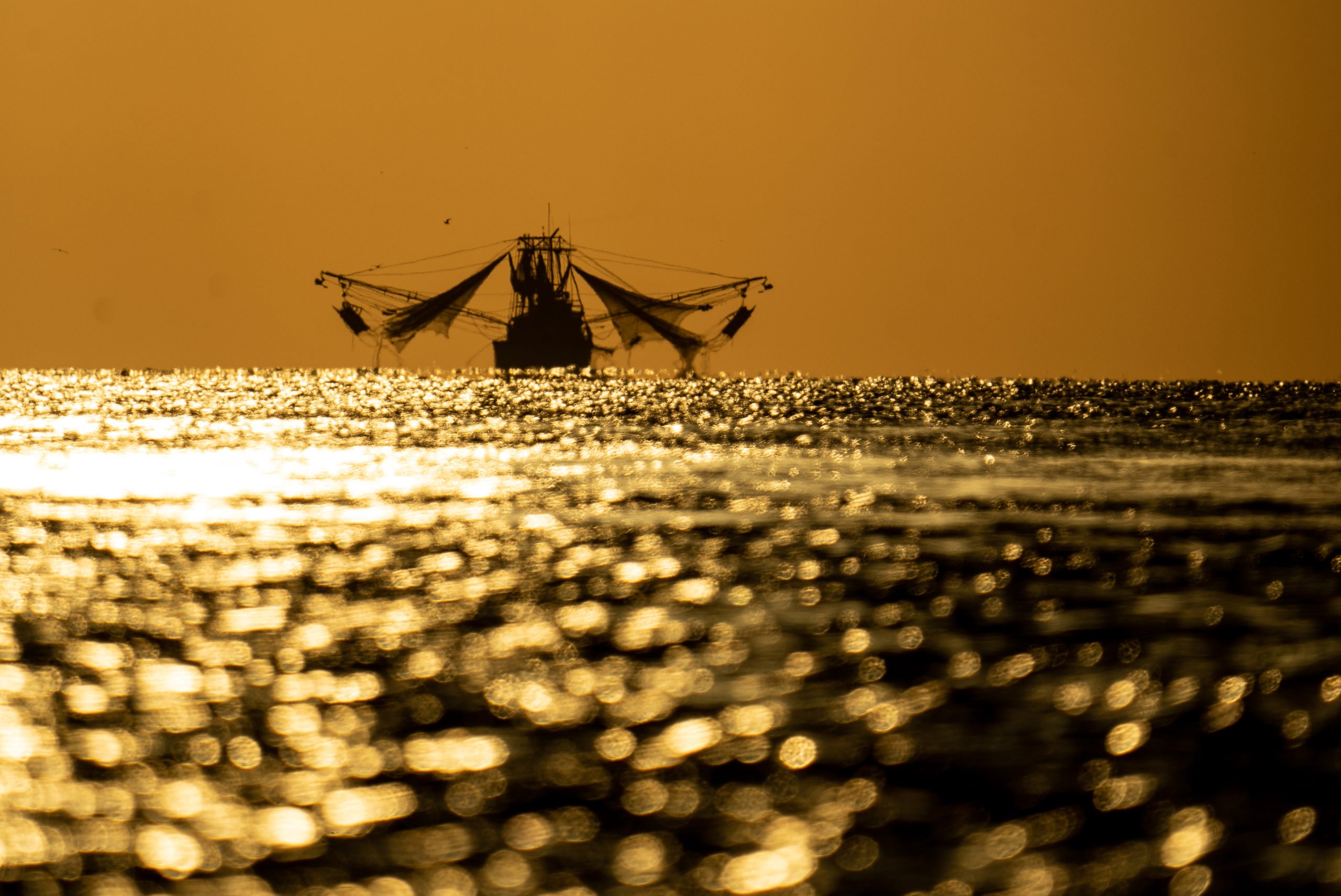
9 – A properly stocked beer fridge is crucial after a warm day of fishing and luckily New Orleans sports some really good beer. Find some cans from Urban South Brewing and NOLA Brewing for starters.
10 – If you’re fishing in southern Louisiana, you’re likely flying into and out of New Orleans. This was my first trip to NOLA, but won’t be my last, and anyone headed to the marsh needs to spend a couple days enjoying the city. It sounds deranged, but I would visit NOLA even without doing any fishing. The cuisine and music are worth the trip alone. The WWII museum is humbling and awe-inspiring, and the weather is a welcome break from gray or snowy northern winters.
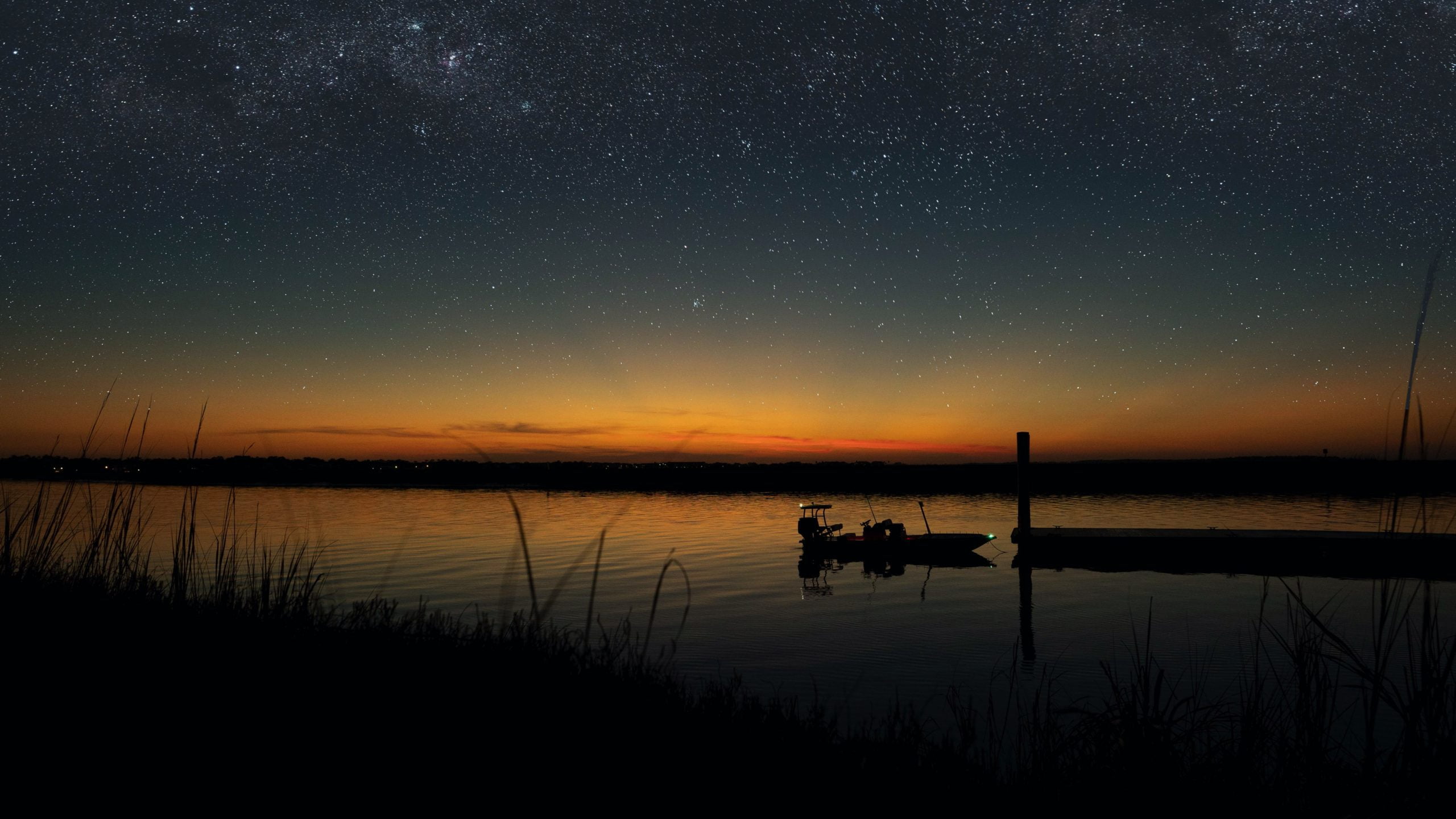
Again, I’m still green when it comes to roping Redfish, but I think this list is a good starting place when considering a trip to the marsh. Having fun is the most important part of a fishing trip and going into it with the correct gear and expectations goes a long way to putting smiles on faces.
If you’re interested in joining Brett on a trip to the marsh, or elsewhere, he hosts trips throughout the year and can be found at www.tailoutanglers.com or on Instagram @tailoutanglers.
Photos by Tyler Bowman (@t.bowcreative)
FEATURED PRODUCTS:
 Saltwater AirThe preferred choice for saltwater applications. The Saltwater Air excels in situations where accuracy and delicate presentations is paramount. | 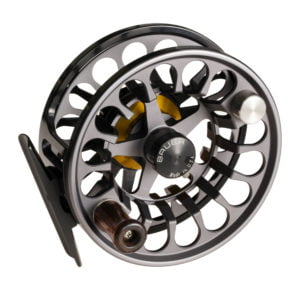 Bauer RXDesigned with saltwater applications as the goal, the RX features a bulletproof, sealed drag package. There is no compromising when it comes to quality. |  Legacy HoodieThe very comfortable hoodie features a vintage Winston design from our 1993 catalog and is designed to be worn on and off the water. |  Trout Tech T-shirtsFeaturing a super comfortable poly-cotton blend, our Trout Tech T-shirts are a favorite among anglers. |
by Winston Rods | Nov 23, 2021

Words by Brett Wedeking
I live and die by the tides. The ebb and flood dictates everything about when I launch my boat and where I choose to fish. If the tide dictates I meet my clients at the boat ramp at 4:30am I obey. Bleary eyed, too early for coffee, my clients obey too, though they much prefer banker’s hours tides. However, once I hit the throttle all sleepiness melts away with the Seattle skyline as we head west in search of saltwater trout.
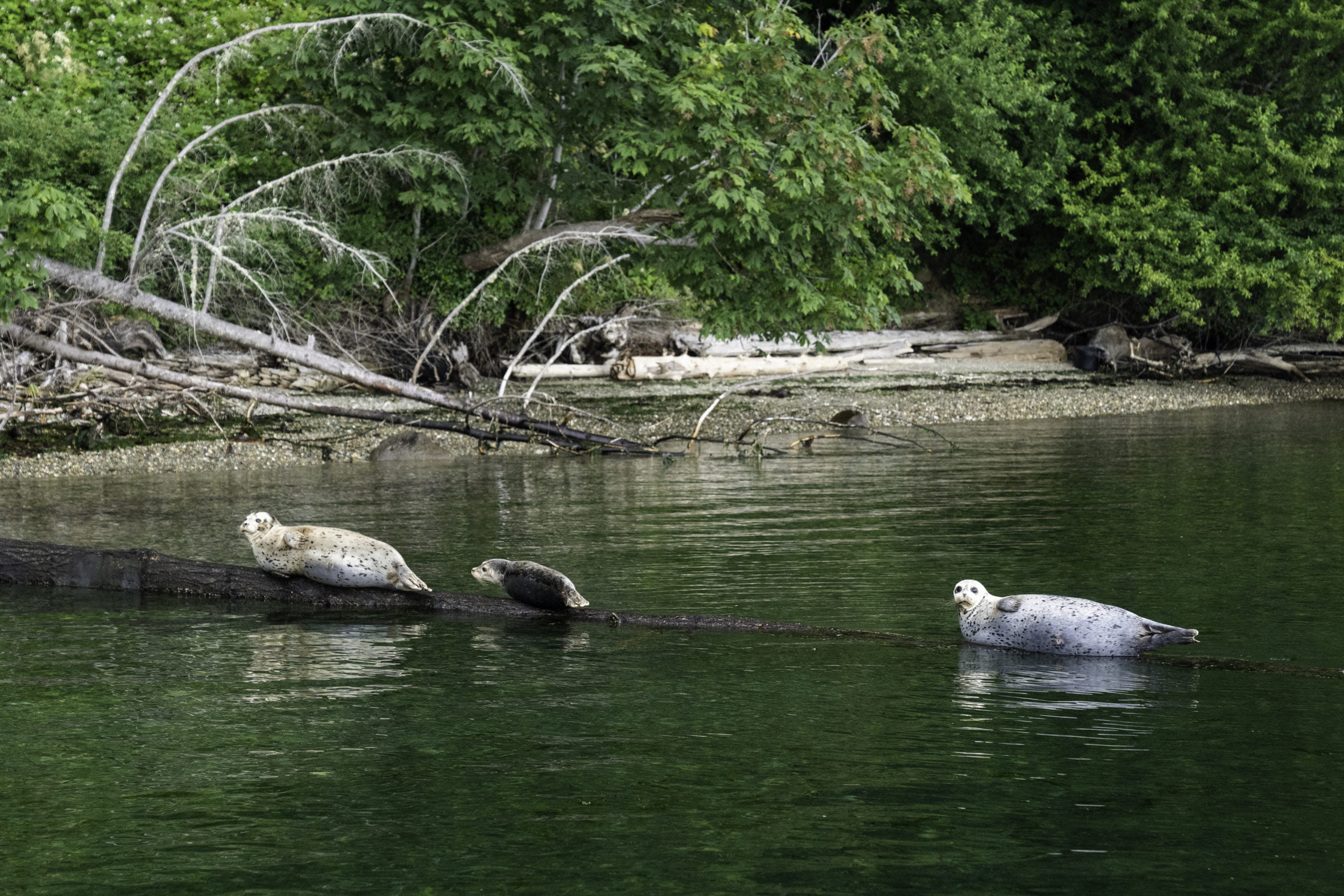
Sea-run cutthroat (SRC’s) are anadromous salmonids. Much like steelhead, they are born in creeks and rivers and then migrate to saltwater where they grow into adults before returning to their natal waters to spawn. Cutthroat however, don’t travel into the open ocean, instead making their living in the nearshore environment throughout the West Coast of North America. My little slice of water is Central Puget Sound, where sometimes we catch cutthroat within sight of the Space Needle. This is my favorite fishery in the Pacific Northwest, not only because the boat ramp is 15 minutes from my front door, but because the entire quest is unique, dynamic and always challenging.
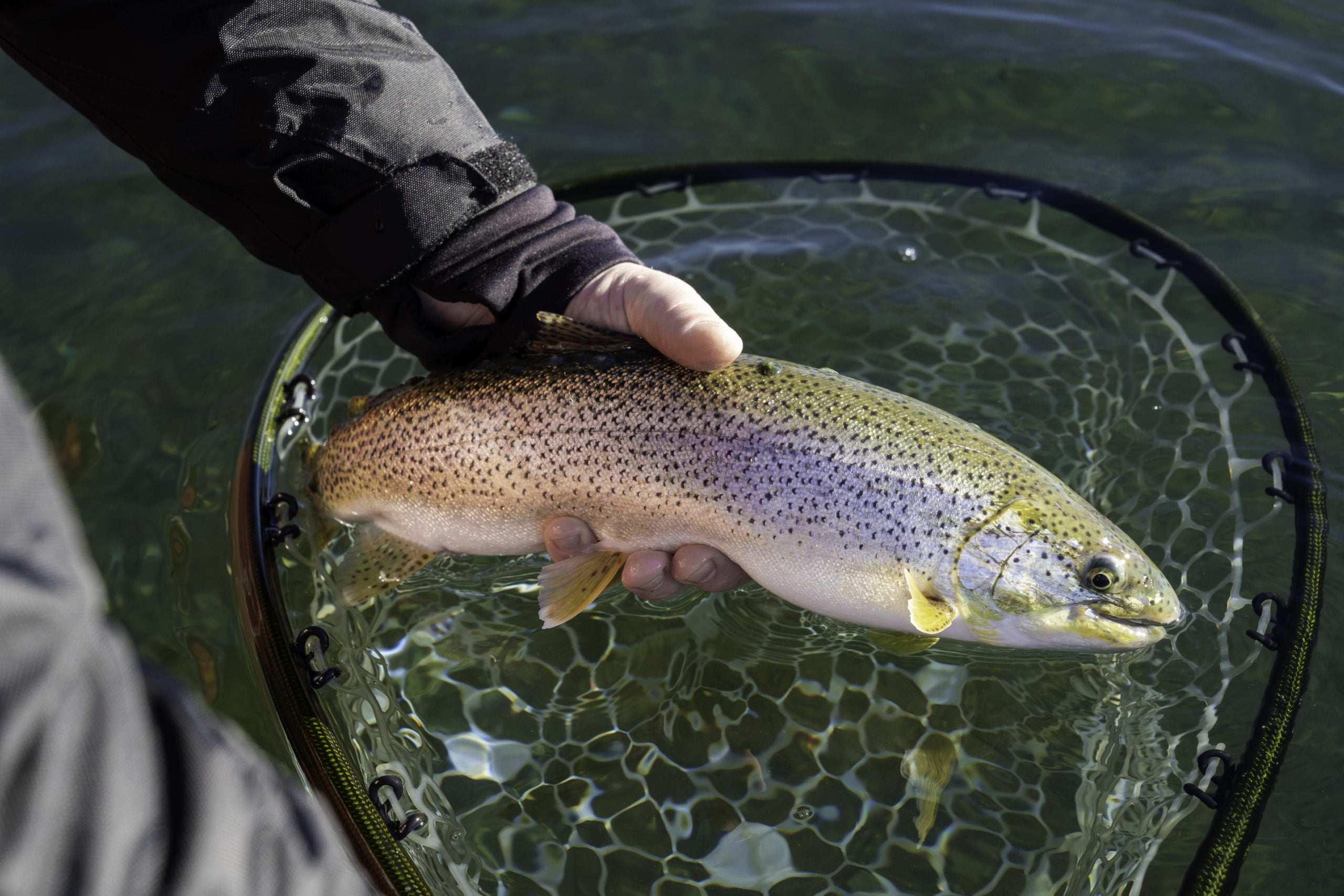
SRC’s roam the shallow waters of Puget Sound in pursuit of a number of food sources including herring, sand lances, salmon smolts, shrimp and worms. Consequently, the fishing is pure joy for the streamer junkie. Stripping small, sparse streamer patterns is the preferred tactic for the fly rod and an absolute blast when with these aggressive fish.
The grabs are hard and the fish scrappy, their beautifully spotted fins and flaming jaw line a works of art. They aren’t near the size of their steelhead relatives but SRC’s occupy an important ecological niche and the Puget Sound population is robust enough to support a thoughtful catch and release fishery. The fishing is seriously visual too; you can often see one or more fish chasing down your fly as you frantically strip it back to your rod tip. Follows, grabs and hookups are common, but these aggressive fish are wily. Sometimes we see large numbers of cutts but only bring a few to the net. Like most fisheries, we don’t base success on how many we land, though when times are good it feels like the net will get worn out. I know I’m biased, but I think this is the most underrated trout fishery in the country.
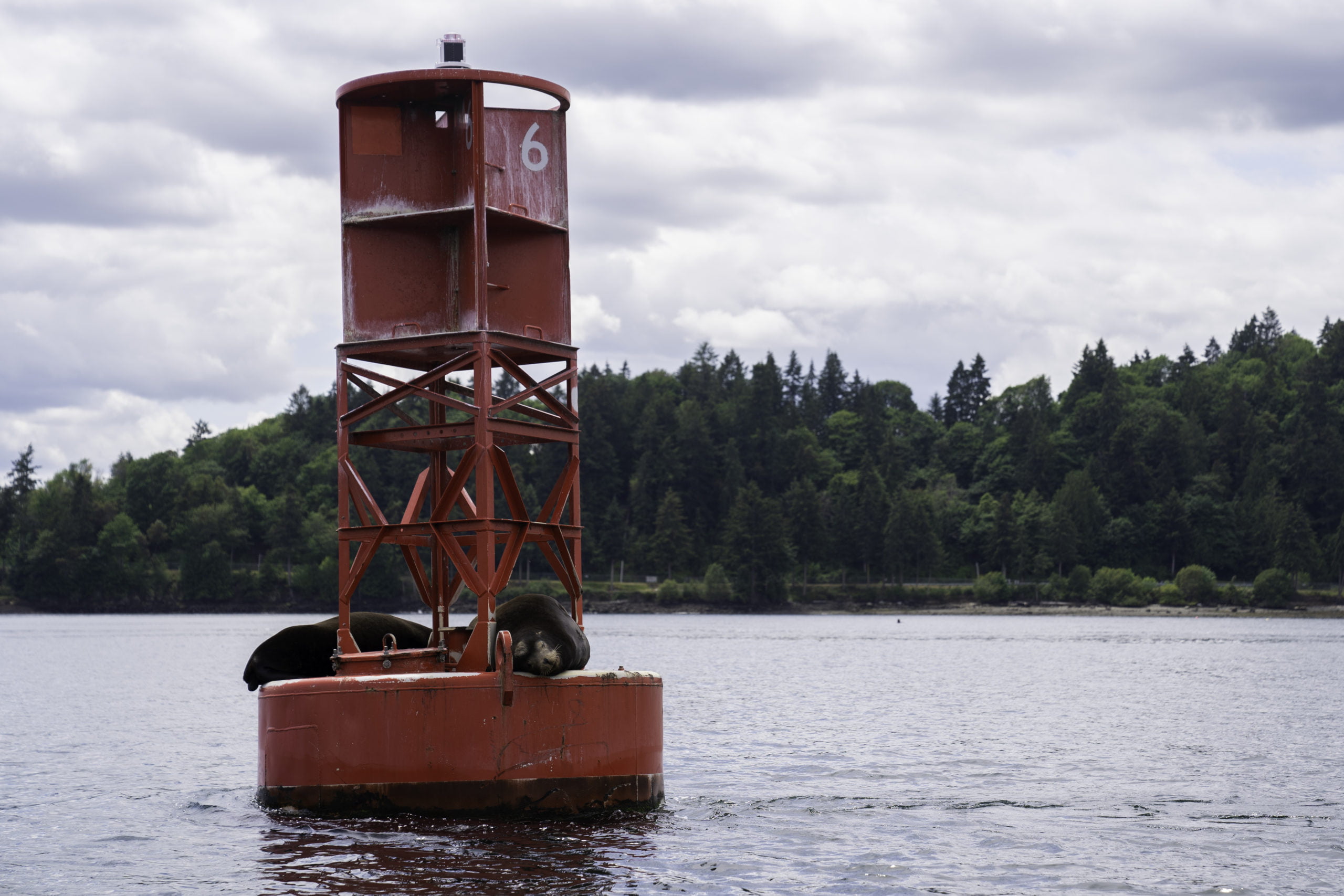
The tidal waters of the Sound move more than the uninitiated expect, with some spots looking and flowing like a river. I fish from a boat and use an electric trolling motor to control the boat as we drift along with the current, casting to juicy spots along the beach. SRC’s are ambush predators, they use the current along with boulders, shelves, eel grass, and whatever else they can us to disguise themselves, and wait for prey to make a mistake. Sometimes we can induce them into making a mistake too. This fishery is fleeting so when the fish are hot and grabby we make the most of it before it disappears. With the tidal changes go the bait and therefore go the cutthroat. The constant fluctuations keep me thinking and make it hard to get bored since we never fish the same exact piece of water twice.
One of the pleasant aspects of the fishery is we aren’t out there blind-casting 10-weights all day. We mostly fish 6-weights and slow sinking shooting heads. Rods like the 9’ #6 Alpha+ or the Air 2 are the dealer’s choice for this type of fishing. They are powerful and accurate for breezy days yet sensitive and supple when it counts. Line speed is key to turning over weighted flies at distance and these new Winston offerings shoot laser beams.
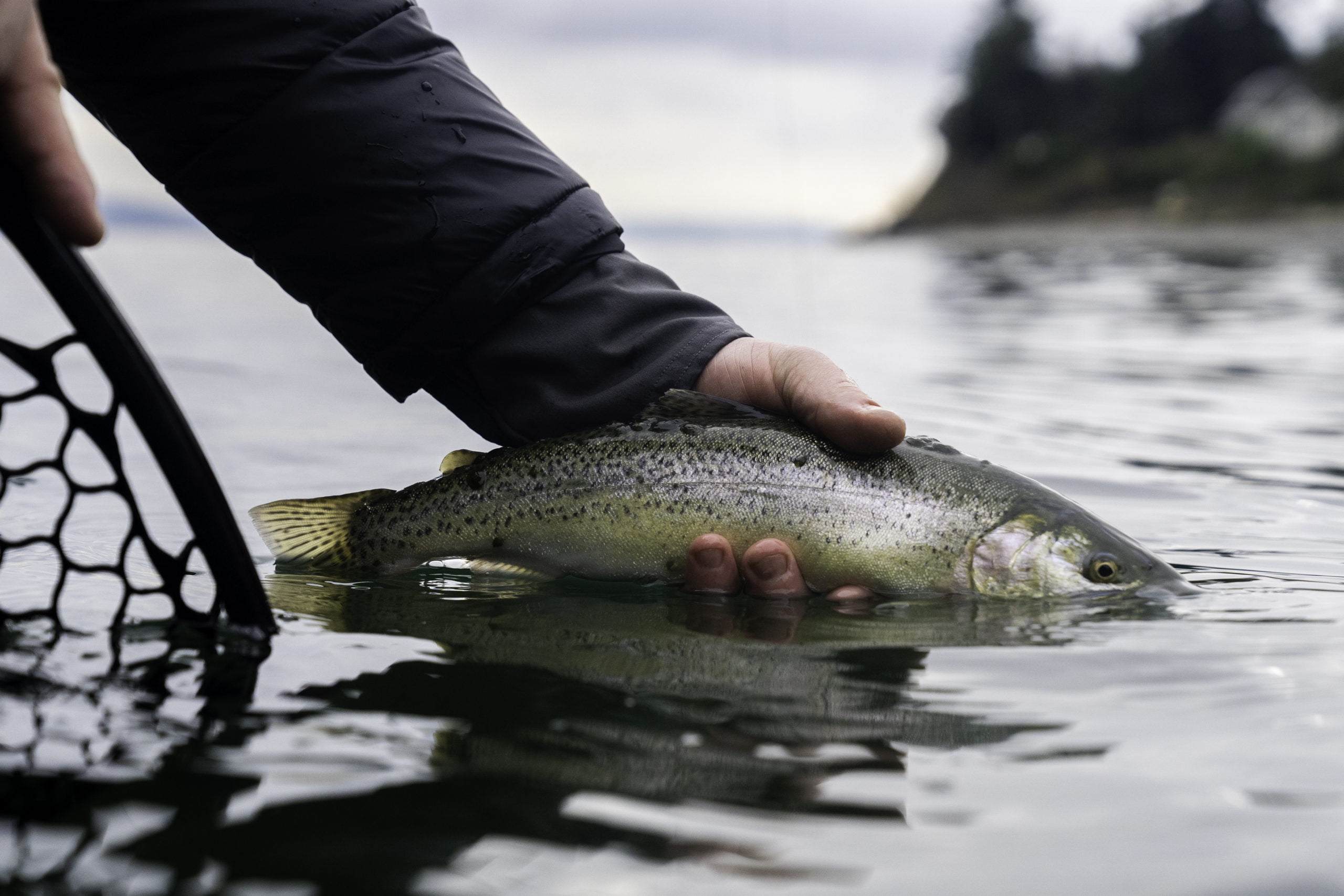
Fishing Puget Sound is about more than just cutthroat. We often incidentally encounter salmon on the same beaches as we fish for cutts, though I’m not licensed to specifically target them, salmon are fun bycatch. Seals, sea lions and bald eagles are ubiquitous and we often spot porpoises, otters and deer through the day. If we get really lucky we may even see orcas, that is if we have time to look away from bent rods and a net full of fins.
For more info on Seattle, Washington fly fishing, check out Tailout Anglers or @tailoutanglers on Instagram.
Photos by Cole Leishman
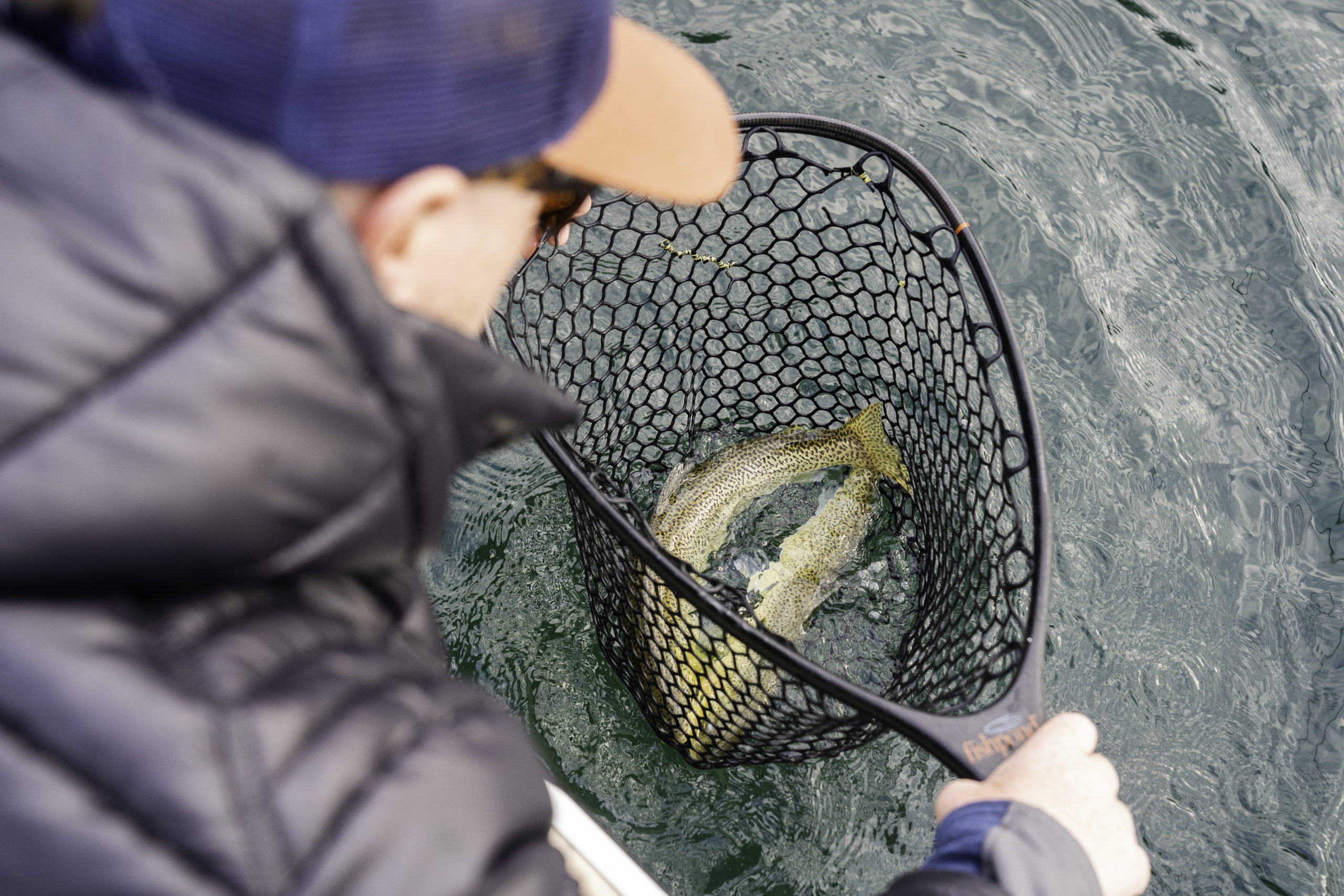
Check out this featured gear:
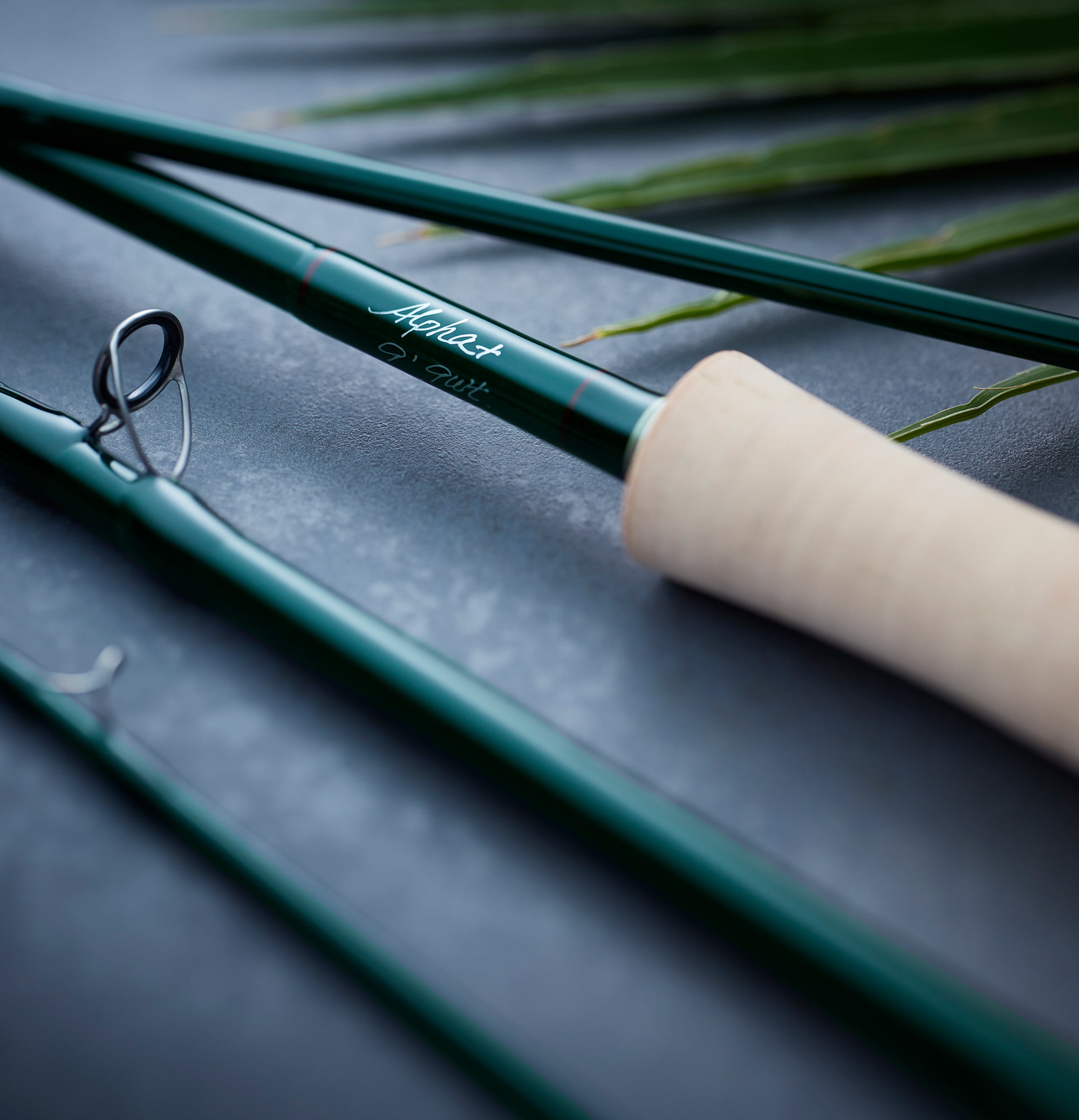
Alpha+With wicked fast action, ALPHA+ rods have been designed to cast aggressive rigs – including big flies, heavy lines, shooting heads and sinking tips. | 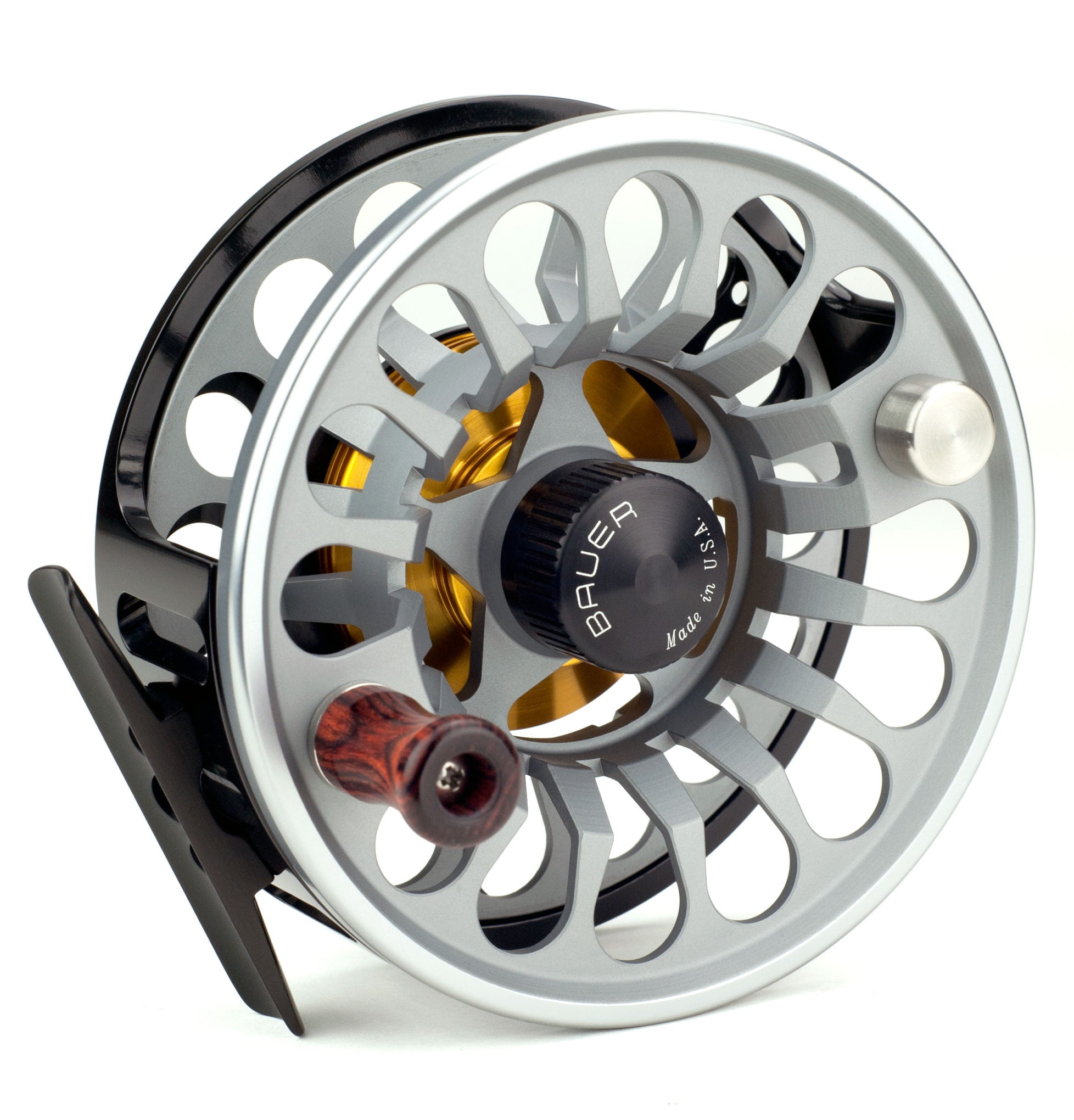
Bauer RXFeaturing awesome performance, superb quality and a beautiful, contemporary aesthetic, RX trout and saltwater reels represent the pinnacle of manufacturing and design, and redefine “smooth and reliable.” |  Legacy HoodieYour new favorite hoodie for cold weather. This extra-heavy top features classic Winston artwork and a poly-cotton fabric blend that won’t shrink in the wash. | 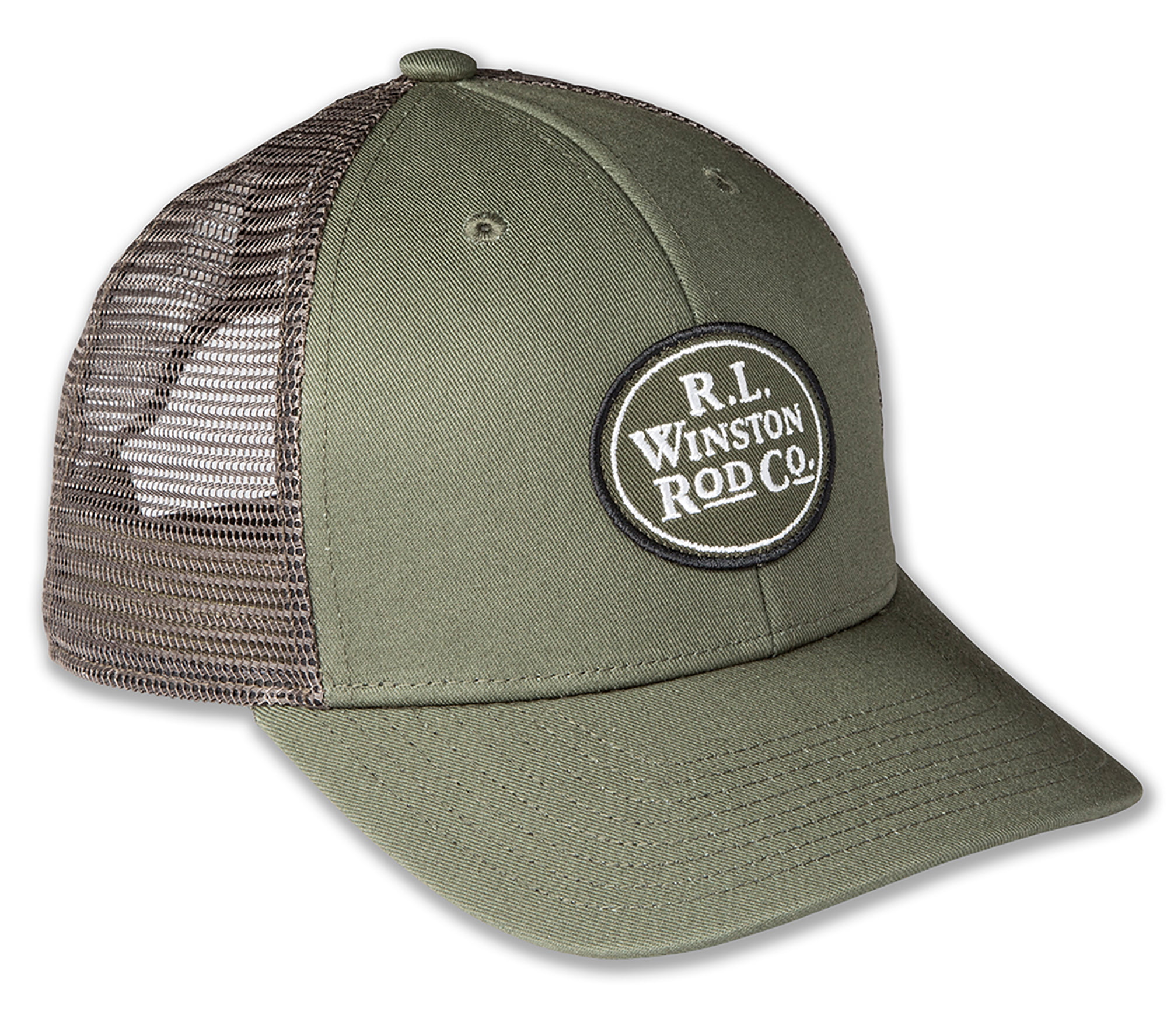 Double Haul Trucker HatOur classic trucker features the infamous oval logo and an adjustable snapback. The Double Haul Trucker is a year-round fishing hat and a favorite among anglers. |
by Winston Rods | Oct 20, 2021
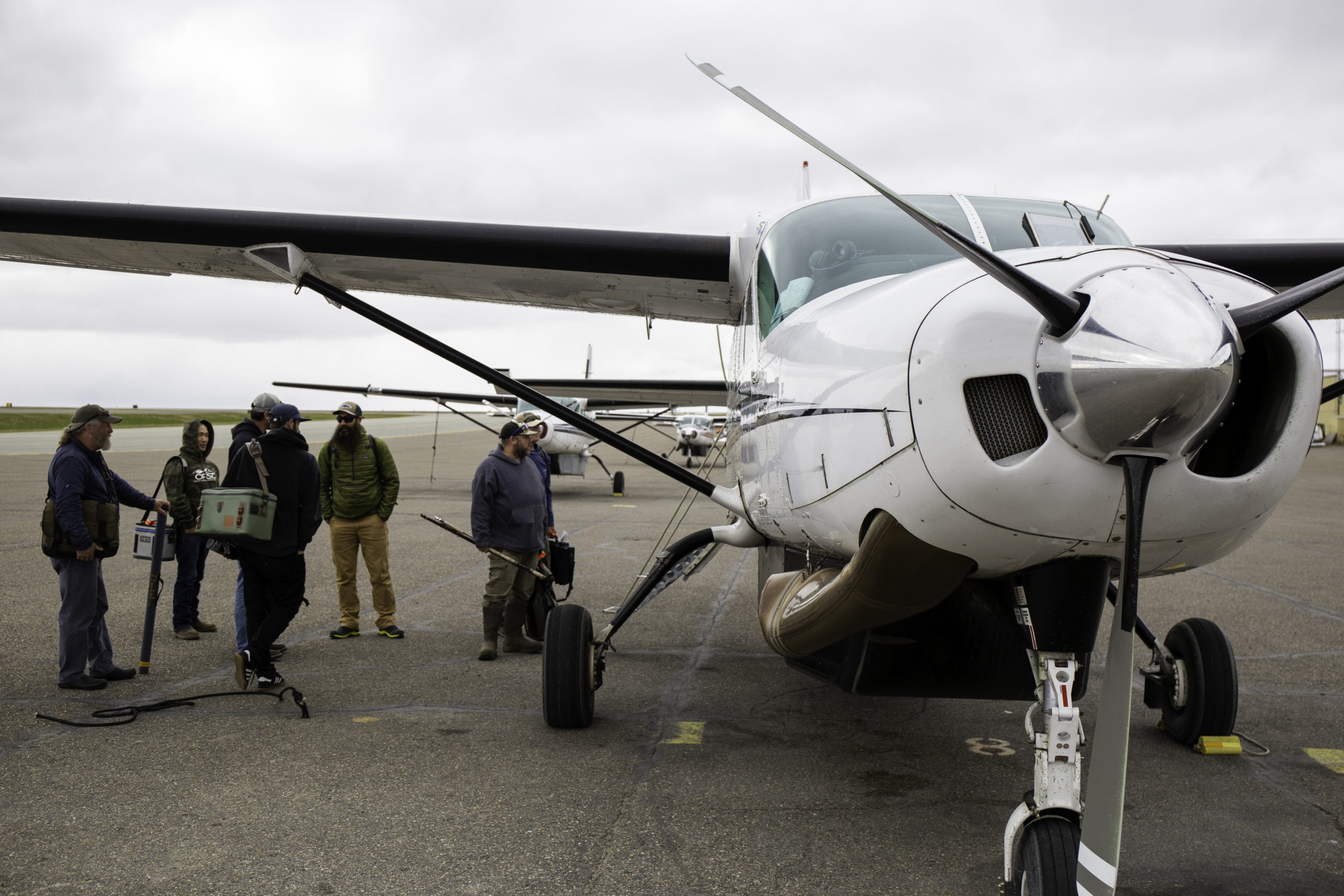
Words By Glenn Chen
As the glorious but brief northern summer draws to a close, a chill in the air and shortening daylight signals the onset of autumn – and with the change in seasons, comes the delightful opportunity to pursue coho with a two-handed rod and swinging fly.
Silver or coho salmon (Oncorhynchus kisutch) are members of the Pacific anadromous salmonid clan that are avidly pursued by legions of fishermen up and down the west coast. This species is a favorite fly rod quarry: the fierce grab followed by spectacular leaps and hard charging runs from a hooked silver is one of angling’s most exciting thrills, and I savor the memories of such wonderful battles well into our Alaska winter months of frigid cold and prolonged darkness.
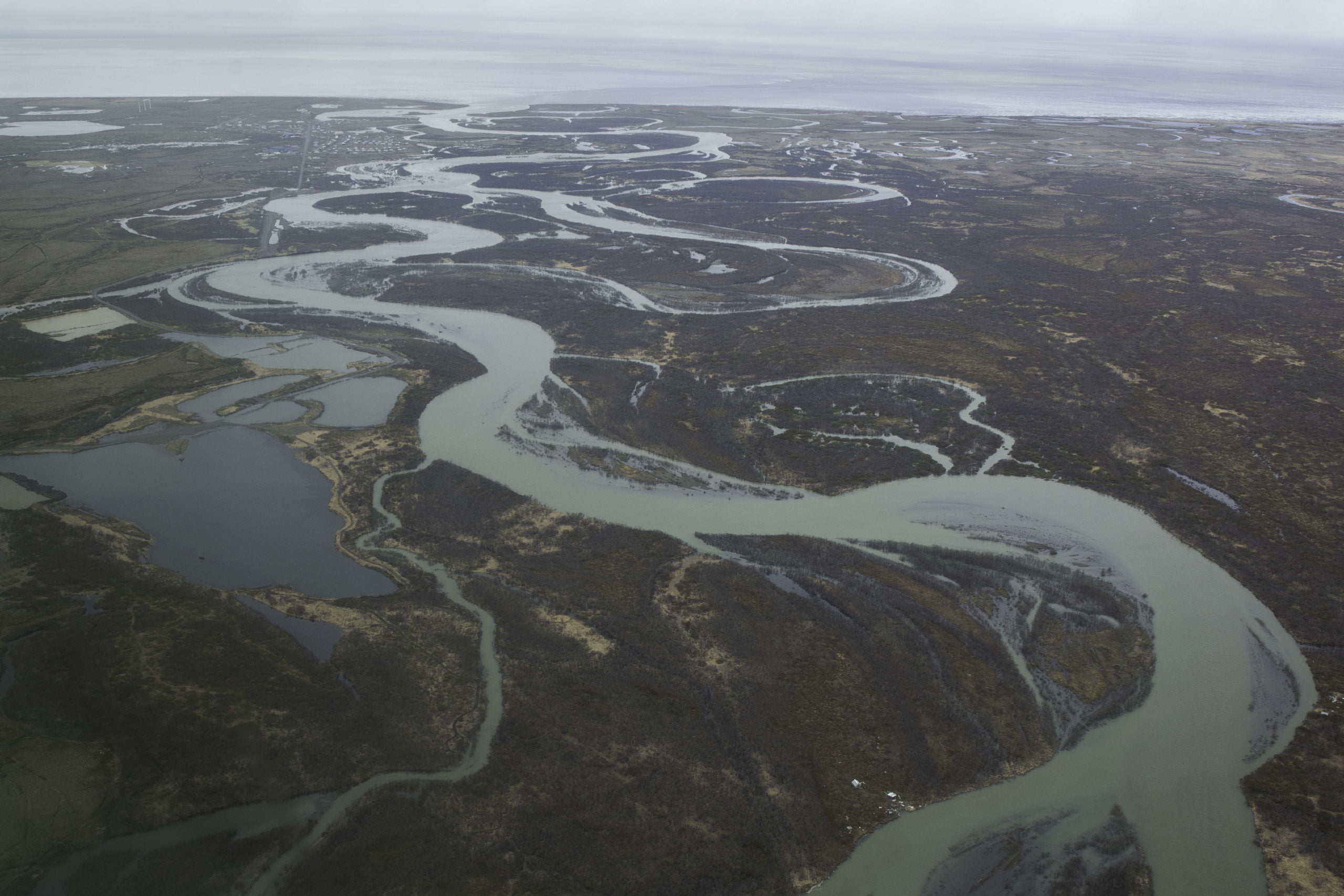
Cohos are enjoyed by double-hand rod devotees, and those who are learning how to use such tackle will marvel at their responsiveness to a swung pattern, with the abundant opportunities for multiple hookups offering an excellent introduction to Spey fishing techniques. My first successful catch on a two-handed outfit was a silver salmon… the big buck smashed my streamer as it neared the end of its arc, and ripped the line out of my hands as he tore away across the swift current, with the ensuing howl from the Hardy reel adding the perfect ambiance to this delightful experience.
For small to medium sized streams, I deploy the Winston 11’6” 6-weight switch rod, short Skagit head, and a 10’ T8 sink tip – or a 5’ floating/5’ T8 sink tip combination – to swing articulated streamers. Larger rivers require a 7-weight (with the 13’3” Winston Spey being my preference), to cover the water with a full length Skagit head and a 10’ T11 sink tip (or a 5’ floating/5’ T11 sink tip combination, for shallower areas). I’ll go to a heavier rod (e.g. the 8-weight Winston 13’3”) during higher flows or when a heavier sink tip/fly is needed. Unless the water is low and clear, a 3’ – 4’ monofilament leader in 15# to 20# test looped onto the line tip will suffice for most coho angling situations.
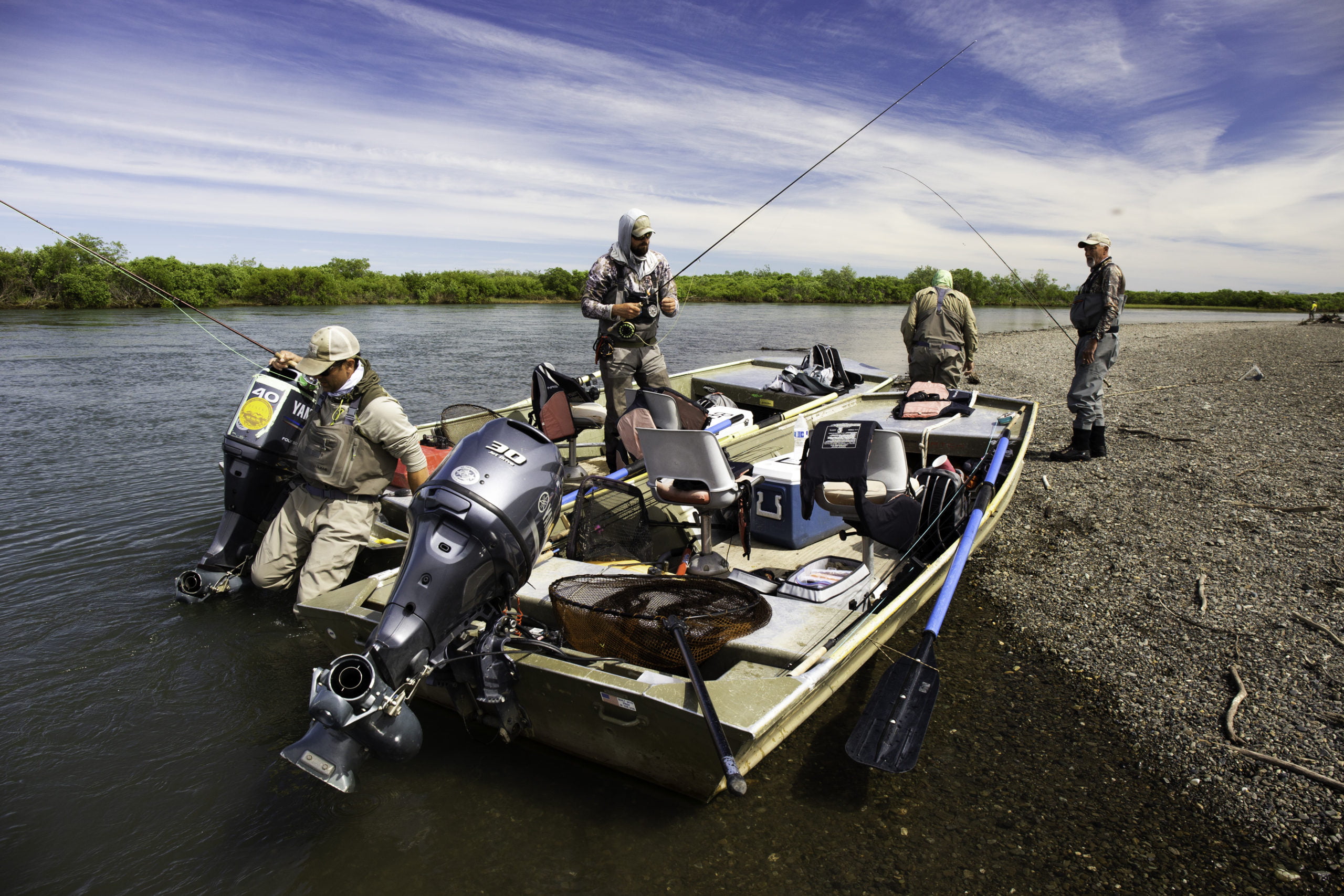
Silvers prefer a fly with considerable action, so many fishers will employ a pattern with weighted heads (and an abundance of wiggly material plus flashy tinsel) that can impart an up and down motion via “false strips” — by pulling and releasing line repeatedly, about a foot each time — as it moves across the current. Strikes can occur at any moment, and these fish will often follow the streamer through the entire swing, so I’ll add a series of false strips at the conclusion of the arc to provoke them (and be prepared for the “hang down” grab that’ll occur directly below you).
In freshwater systems, cohos usually avoid swift velocity areas, so seek out the softer edges and slower runs that’ll still have sufficient current to swing your fly. As these salmon will strike patterns that are moving slightly above – but not below – the depth where they are holding, select the appropriate sink tip and streamer weight to ensure that you are fishing at the correct level in the water column. I’ll start with a bright pink articulated pattern, switching to a darker color (e.g. cerise/purple or black/chartreuse) to continue enticing the fish on successive passes; move to a new spot once all the biters have been hooked.
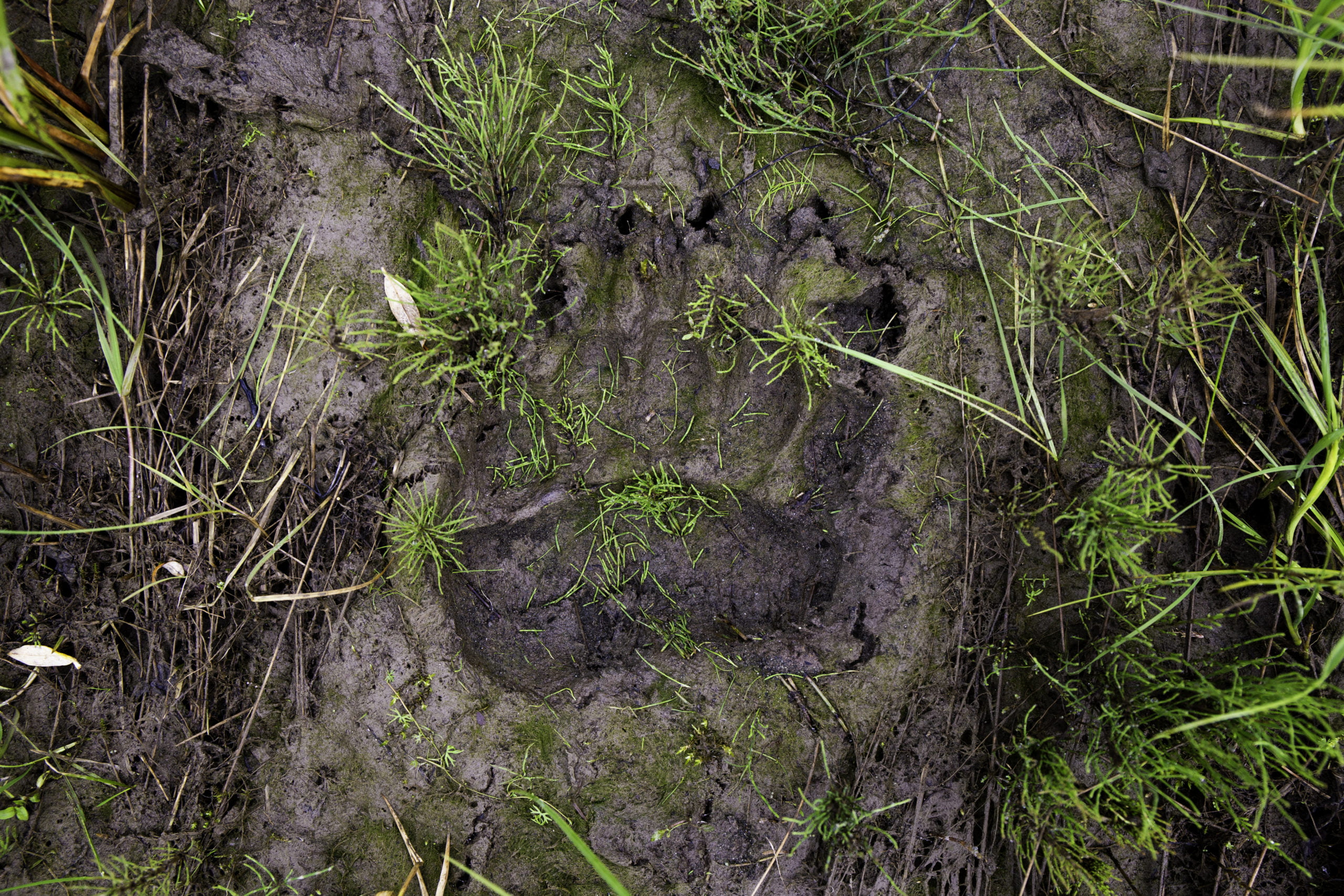
For the optimal coho swing fishing experience, head to a remote coastal watershed in Alaska where angling pressure is light and the salmon are abundant. Systems such as the Sapsuk, Kanektok, or Ayakulik rivers (to name a few) host large runs of sea-bright fish and have ideal conditions for two-handed swing angling. Mid-August through late September are the optimal weeks to pursue Oncorhynchus kisutch in these wilderness settings, where humans are vastly outnumbered by the piscine and wildlife denizens. Tent-style camps and lodges reached via chartered air flights cater to visiting fishers, and jet boats provide transportation to spots where you wade and cast in these rivers.
On a recent trip to the Alaska Peninsula during early September, our timing was perfect, as wave upon wave of mint-bright silver salmon swarmed up the river and attacked our swinging flies with abandon. We fished with three anglers per guide, and triple hookups occurred so frequently that we grew to expect this upon arriving at every coho-laden run. My Winston 7 and 8-weight Spey rods were constantly bent on fish that ranged up to 14 pounds; changing fly colors plus sink tips enabled me to maintain constant action throughout each day. Because our camp was located adjacent to the prime water, a number of us would continue our fishing post-supper, until the resident brown bears arrived for their evening repasts and caused a tactful retreat back to the safety of our electrified compound.
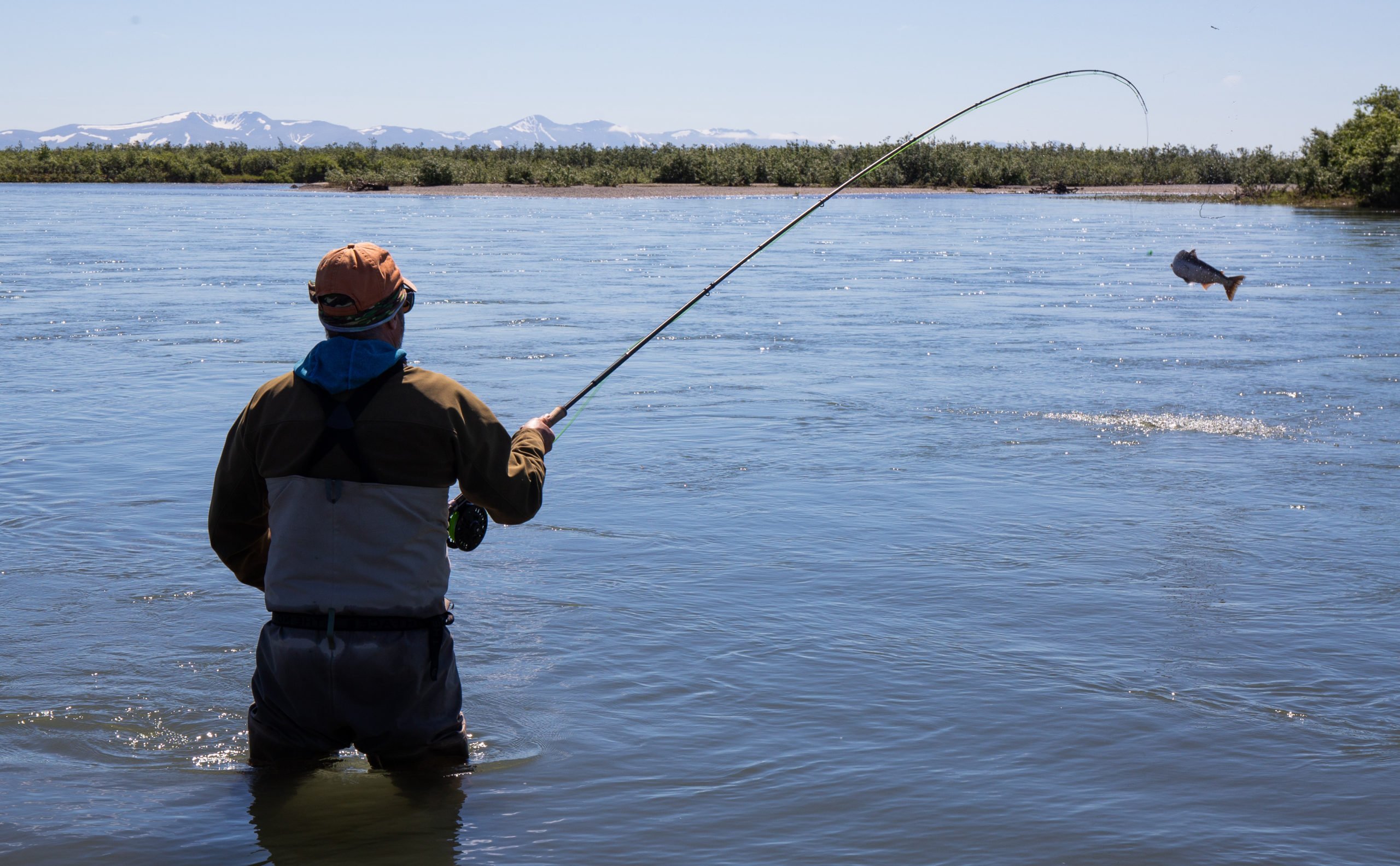
Surface gurglers fished on switch rods and floating lines provided an exciting option to sunken flies, with the best top water action occurring early in the morning. Throughout each day, pods of kisutch could be seen chasing our offerings, with the most aggressive and swiftest ones grabbing, then screaming away and vaulting high in the air upon feeling the hook (which were barbless, to facilitate their release). Head guide Mike Flynn was kept busy with his netting duties, and big grins plus high fives celebrated each successful capture.
One afternoon, I had our guide Trevor Covich drop me off at a spot where we had seen squads of silvers lined up along a willow-choked bank. This place had been unfished due to the deep, soft mud along the entry shore, which I struggled through to reach the constantly rolling fish. To my pleasant surprise, the clinging silt gave way to firm gravel as I approached the thalweg, and I was able to throw a long line out against the far bank. The 4-inch long, chrome cone head streamer began its swing, and was instantly grabbed as I made my first false strip. A big hen dashed downriver and cartwheeled high in the air, then proceeded to empty my Hardy Duchess reel with the Winston Spey rod bent all the way to the cork handle. I made successive casts from each spot until there were no grabs, before taking the next steps down the run. Ninety minutes of blissful action passed by thusly, before Trevor returned to pick up a very satiated angler to rejoin his companions for the short boat ride back to camp that evening.
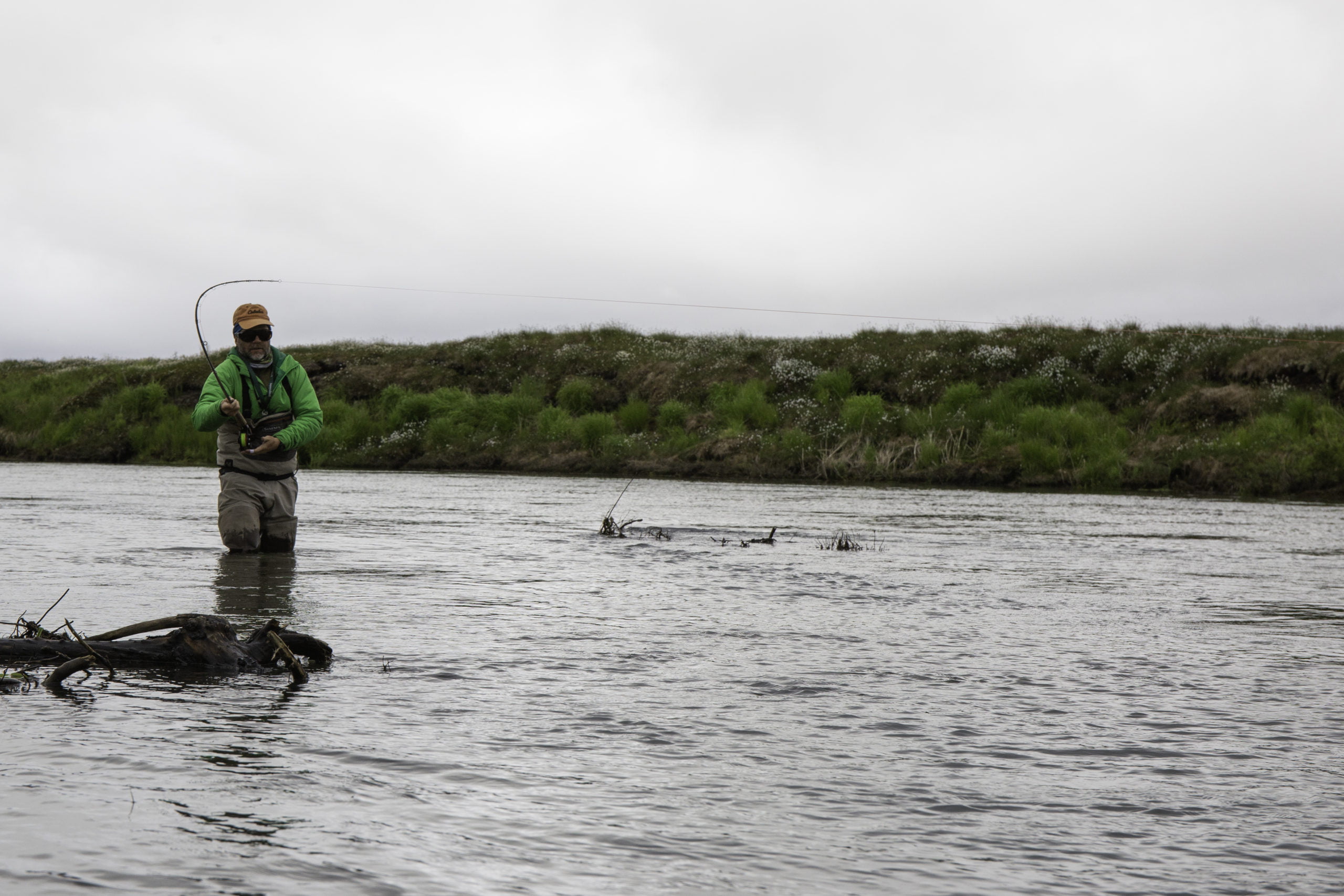
The final kisutch of this trip proved to be the most memorable. I was fishing just above camp at a run called Silver Tree, so named for the big alder where cohos would stop to rest on their upstream sojourn. As I cast my Winston 8-weight Spey and swung the big cone head fly, it was smashed by an enormous coho just outside the overhanging branches. The big buck powered his way across the strong currents, then decided that his route to freedom was via a swift return to the Bering Sea. The click pawls on the Hardy erupted into a banshee howl as the fish made a stunning run towards the rapids hundreds of yards below. The river’s surface blasted open as he leapt repeatedly during this mad dash; I saw that this fish was far bigger than any I had encountered during the week, and I despaired over the slim odds of landing him in the heavy flows, as I was unable to get around the tree to follow. He finally stopped just above the start of the choppy water, and in desperation – with the hope that the barbless hook would somehow remain attached to his jaw – I quickly stripped out line and let it belly below the salmon. To my relief, this worked, and he began to swim back upriver against the downstream pull of the Skagit head. I slowly worked him towards me, but had to repeat the tactic as the fish tried again and again to flee in the opposite direction.
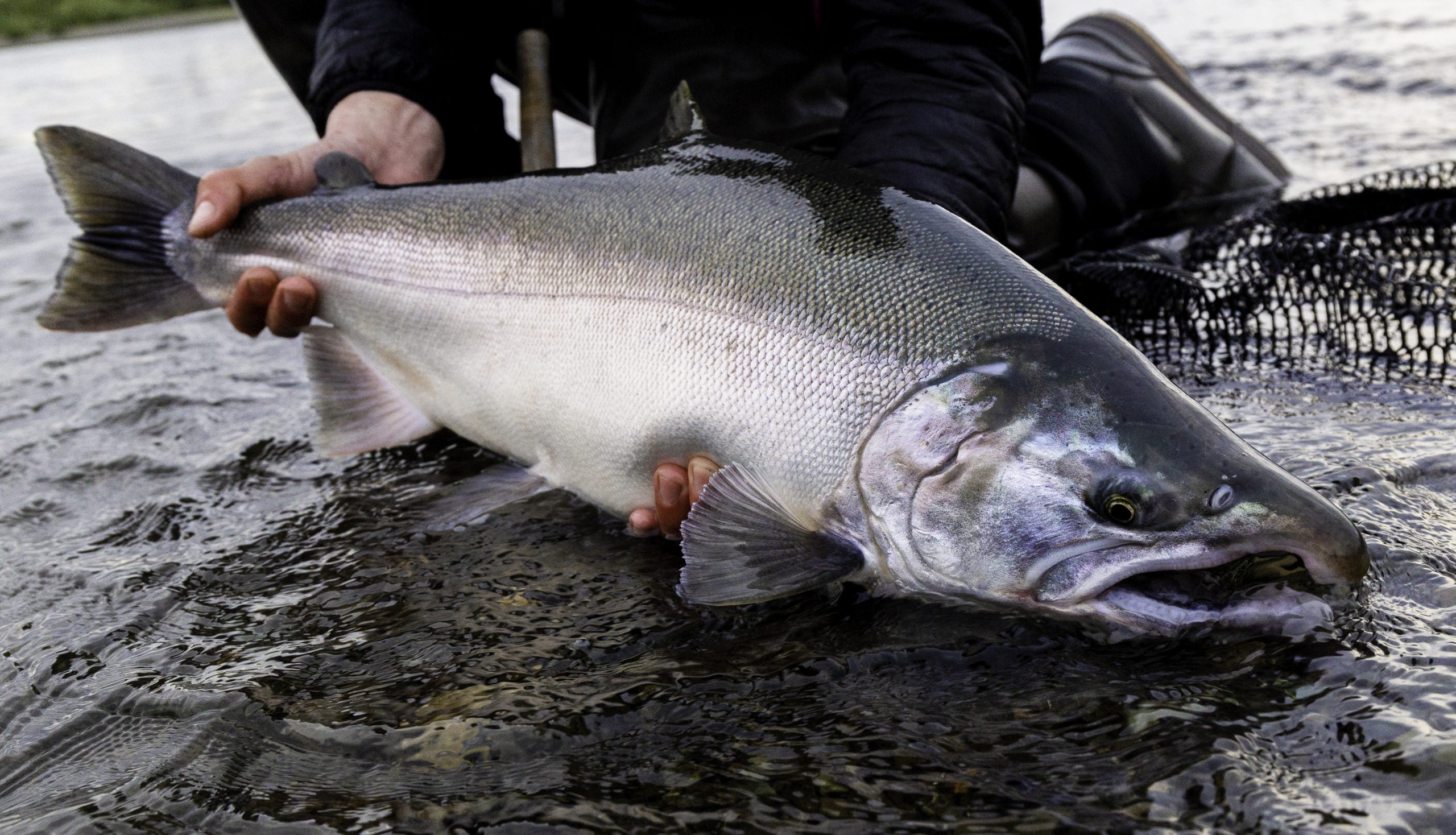
After many long and anxious minutes, I had coho within a few yards of me, but he stubbornly refused to move out of the current. I bent my rod deeply as I led him downriver and tried to draw him towards the quiet water along the bank – but the salmon would flex his massive body and power back into the flows. It required a dozen attempts at this merry-go-round before I was finally able to slide him into the shallows next to my feet. I could barely grasp the broad peduncle above his tail with both hands, and managed to snap one photo before the hook fell out of his mouth — whereupon the fish sensed his freedom and dashed back into the channel, dousing me with spray as a final salutation from a worthy opponent. I hope that his progeny successfully return to challenge future silver salmon Spey anglers!
Photos by Cole Leishman
Check out this featured gear:

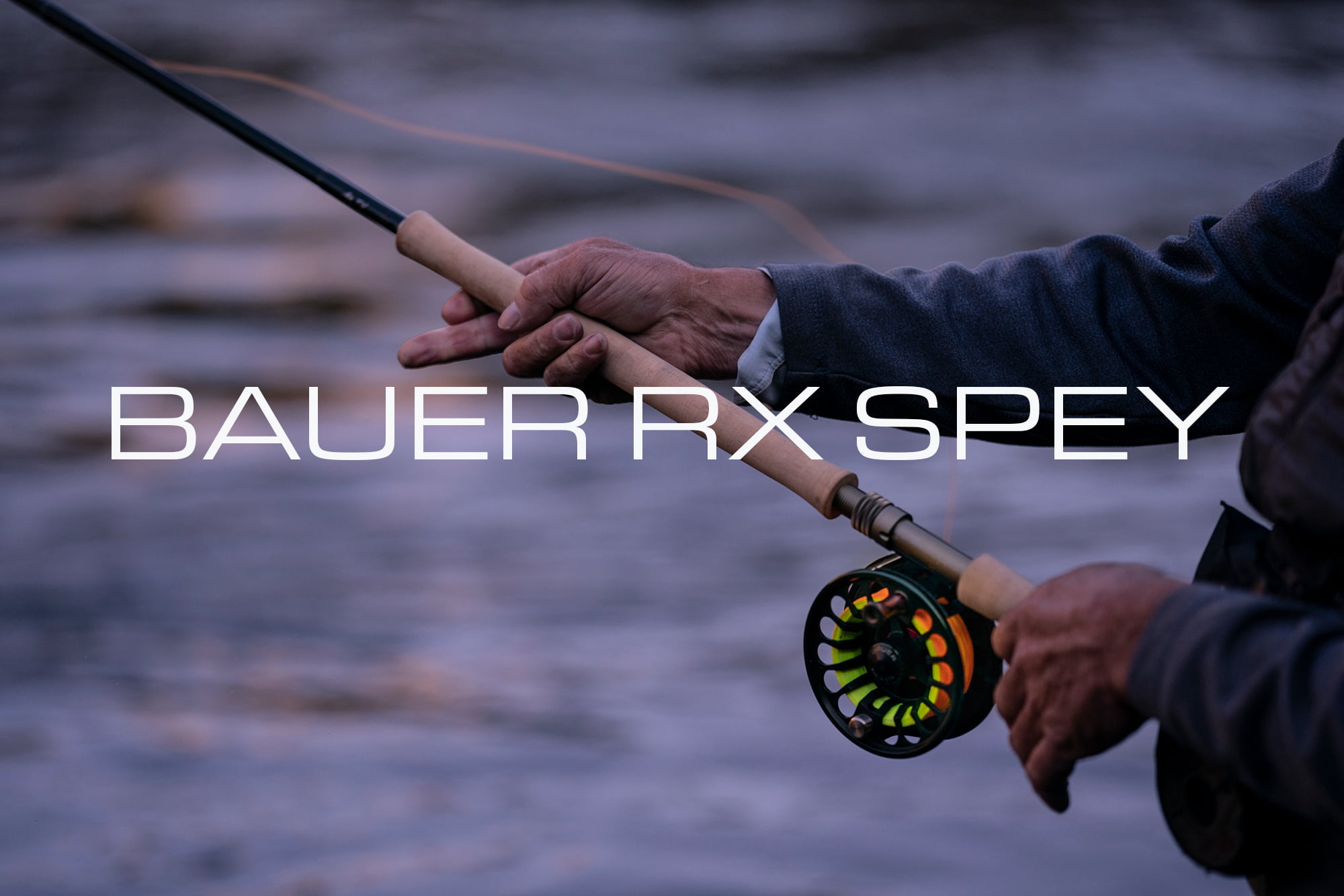
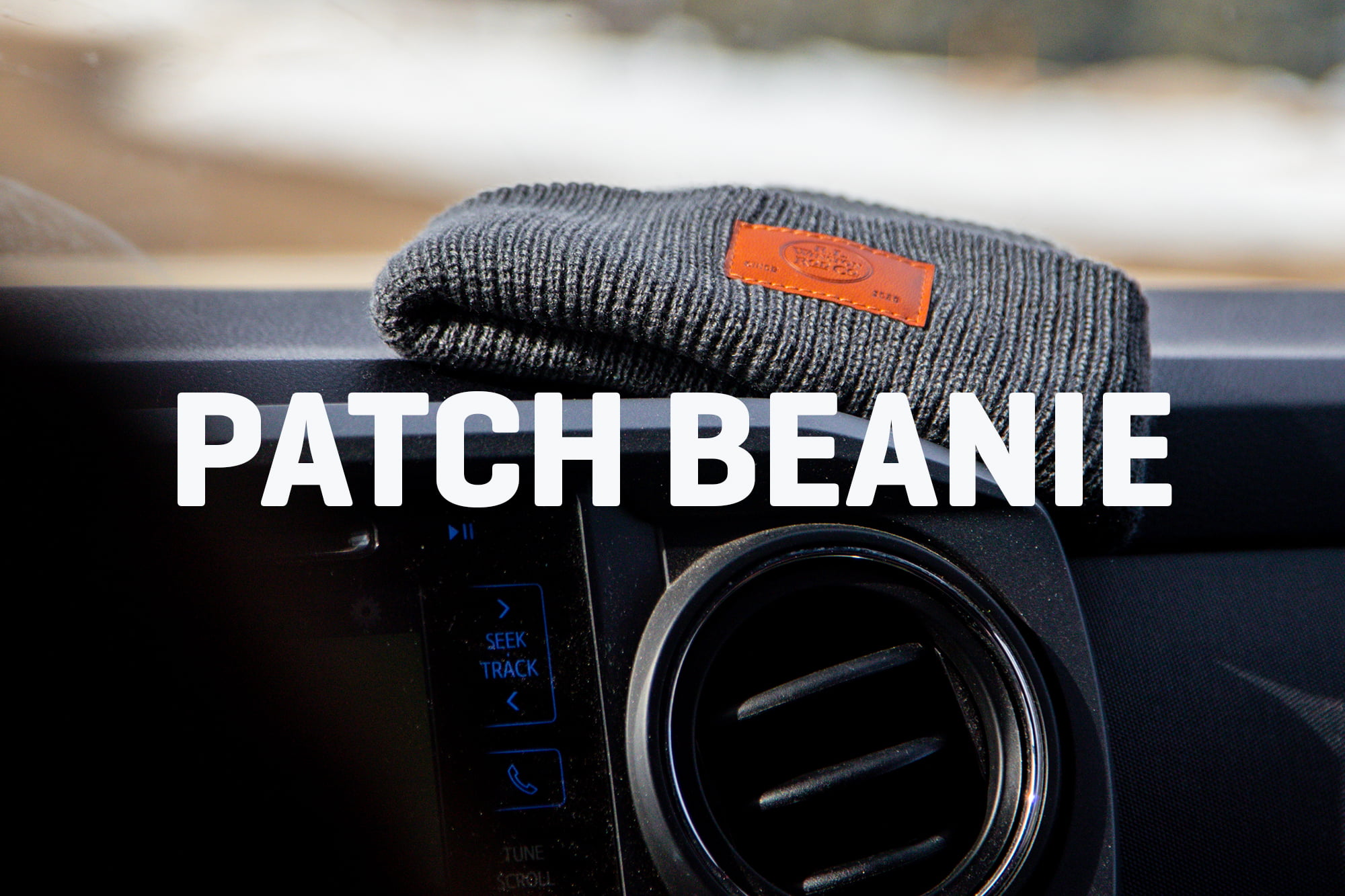





















 Words by John Duncan (Telluride Angler)
Words by John Duncan (Telluride Angler)





































